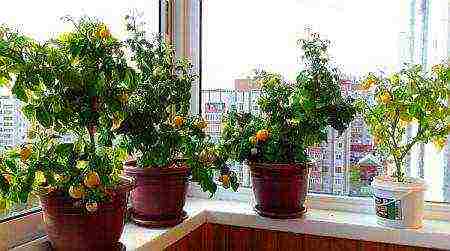Content
- 1 The best varieties of early cucumbers
- 2 Instructions for growing early cucumbers in a greenhouse
- 3 We equip a cozy greenhouse
- 4 Cucumbers in the greenhouse, soil preparation
- 5 Sowing cucumbers
- 6 Cucumbers in the greenhouse, we take care of our favorites
- 7 Formation of vines of cucumbers
- 8 Pollination of cucumbers
- 9 We solve problems
- 10 Variety selection
- 11 Soil preparation for seedlings
- 12 Seed preparation
- 13 Sowing and growing seedlings
- 14 Hardening and planting seedlings in a greenhouse
- 15 Greenhouse cucumber care
- 16 Potential diseases and growing problems
- 17 Greenhouse placement and arrangement
- 18 Video "Greenhouse cucumbers in the country"
- 19 Variety selection
- 20 Soil and sowing
- 21 Care
- 22 Formation
- 23 Possible difficulties
- 24 Video "Technology of a bountiful harvest of cucumbers"
Fresh cucumbers are sold in stores today all year round, but their quality cannot be compared to vegetables grown on their own. That is why many gardeners resort to various tricks to get their first harvest as early as possible. What is needed for this? In fact, not so much - having your own greenhouse and knowing some of the rules for growing early cucumbers.
How to grow cucumbers
The best varieties of early cucumbers
What cucumbers are best for planting in a greenhouse
The main condition for obtaining an early harvest of cucumbers in greenhouse conditions is the correct choice of variety and seeds. Hybrid varieties are best suited for cold and temperate climates - they self-pollinate, and tolerate a lack of sunlight well.
|
Ant F1 |
Plants with limited branching and short lateral shoots. Fruits are small (9-12 cm long) of intense green color with large tubercles. | A super early variety that gives the first harvest in 37-38 days. Resistant to diseases and low temperatures. |
|
Buyan F1 |
Medium-sized bushes with small and short (length 8-11 cm, weight 95-105 g) cylindrical fruits. | An early ripening variety (ripening period 45-54 days), resistant to diseases, as well as changes in temperature and humidity. |
|
Goosebump F1 |
A medium-sized plant with a limited number of side shoots. Fruits with large tubercles, dark thorns 8-12 cm long. | An early ripening hybrid (42-45 days), resistant to diseases, especially to real and downy mildew. |
|
Zozulya F1 |
Bushes with self-regulating branching, fruits are dark green (length 14-24 cm), have weak pimples, pale white stripes and excellent presentation. | An early ripe hybrid (fruits ripen in 46-48 days), resistant to most diseases. |
|
Benefit F1 |
Vigorous bushes with a lot of lashes. Fruits are small (10-13 cm), bright green in color with small tubercles, without a bitter taste. | High-yielding variety, resistant to most diseases. |
|
Emelya F1 |
Plants are vigorous, with medium to few lateral shoots. Fruits are oval (13-15 cm), bright green, with large tubercles, universal use. | Differs in cold resistance, high productivity and amicable return of fruits. |
|
April F1 |
Bushes with a limited number of lateral shoots, cylindrical fruits, dark green, with large tubercles, not prone to yellowing.The length of one fruit is 20-25 cm, weight is 200-250 g. | An early ripe variety, the first fruits appear after 45-55 days. Resistant to frost and most diseases. |
Instructions for growing early cucumbers in a greenhouse
Technology for growing cucumbers in a greenhouse
It is best to grow the crop in a polycarbonate greenhouse with good ventilation and lighting. It is desirable that the structure be heated, but it is quite possible to do without it.
Greenhouse for cucumbers from bottles
In addition, it is very important to follow the rules and steps for sowing seeds and caring for plants in order to get a good harvest.
Stage one. Soil preparation
Soil preparation for planting
Cucumbers love light, fertile clay-free soils, so the soil should be prepared in advance. The following soil compositions are considered the most suitable:
- sod land, compost (50/50) and wood ash in the amount of 8-10% of the total;
- light garden soil (1/4 part), compost (1/3), peat (1/2).
It is also recommended to add a little rotten sawdust to the soil, which regulates the amount of moisture well.
Sawdust application
In addition, for each square meter, you should add:
- ammonium nitrate - 30-40 g;
- double superphosphate - 90-150 g;
- potassium sulfate - 35-50 g.
The soil with fertilizers should be mixed well with a rake, leveled and watered at the rate of 2-15 liters of water per meter (depending on the dryness of the soil). Next, cover the ground with foil and leave for two weeks so that the fertilizers are well absorbed.
Greenhouse preparation
Stage two. Seed preparation
Quality seeds are a prerequisite for an early harvest of cucumbers, so they need to be prepared in an appropriate way before planting.
The germination procedure can be replaced by bubbling (treatment of the seed with oxygen) - this method is more effective, and significantly increases the germination of seeds.
Bubbling
Sparging seeds with oxygen or air
Stage three. Growing seedlings
When choosing the timing of sowing seeds, you need to take into account the fact that cucumber seedlings are transplanted into closed ground at the age of 20-25 days. You can take boxes or cassettes as a container, but peat cups are the most practical option, since the culture does not like picks, and peat containers allow you to avoid this procedure.
Peat seedling pots
In addition, you will need a nutritious soil mixture: manure compost, vermiculite and sod land in equal parts. In addition, ash (glass), urea (teaspoon) and nitrophosphate (tablespoon) are added to it. Mix all components and fill containers with them, then pour hot water over them and allow to cool.
We fill the containers with soil
Water abundantly
We spread the seeds
We fill the crops with soil
Seeds are planted one by one in each cup to a depth of 2 cm and placed in heat (at least 25 ° C). After the first shoots appear, the containers are transferred to a bright place, protected from drafts.
Sprouts of cucumbers
The temperature during the daytime should be at least 22 ° С, at night - 15-16 ° С. Shoot care at this stage is as follows:
- water the plants with settled warm water as the soil dries, but not too abundantly;
- if the weather is cloudy, it is better to illuminate the cucumbers with fluorescent lamps, setting them so that the distance between the shoots and the light source is about 5 cm;
Seedling lighting
- feed seedlings twice. The first time - 2 weeks after the emergence of shoots with a solution of urea (1 tsp per 3 liters of water). The second - after another 6-7 days, a solution of nitrophoska with wood ash is used (1 tbsp ash and 1 tsp nitrophoska per 3 liters of water);
- as soon as the seedlings get stronger, you can start hardening them - in the room where they are located, you should regularly open the window. After the appearance of 4-5 strong leaves, the plants are transplanted into the ground.
In the photo, seedlings of cucumbers
Stage four.Transplanting shoots to the greenhouse
Plants can be transplanted into pre-prepared soil or into the so-called warm beds. It is necessary to choose one or another option taking into account the climatic features and characteristics of the greenhouse itself. In cold climates and unheated structures, it is best to equip manure beds that allow you to maintain the temperature necessary for cucumbers. For temperate climates, compost beds are suitable, and in heated greenhouses and warm climates, shoots can be transplanted directly into closed ground, having previously filled in a high bed (30-40 cm).
How to plant cucumber seedlings in a greenhouse
The timing of transplanting cucumbers can also be different: in manure beds or heated structures - at the beginning of April, in compost beds - at the 20th of the month, and in ordinary greenhouses made of film, which are heated only by the sun's rays - not earlier than May.
How to equip a "warm" bed?
How to make warm beds
For "warm" beds, manure (cow and some horse manure) or any compost (rotted sawdust, vegetable waste, last year's leaves, etc.) can be used. It is possible to plant shoots in manure beds already in early April, and in compost beds a little later, with the beginning of spring warming. To equip such beds and plant seedlings, you need to follow these steps.
Due to the decomposition process that occurs in the substance under the ground, the soil temperature will be quite high (in a manure bed, it can rise up to 30 ° C). This temperature regime can persist for up to a month, after which the bed will begin to cool down. Active growth will begin within 3-5 days.
- When growing cucumbers in a manure bed, weather conditions cannot be discounted. Even if the temperature outside the window is low, in bright sunlight, the seedlings can simply burn out, so it is important to constantly monitor the temperature and, if necessary, open the garden. The shelter is removed after warm weather is established on the street.
- Top dressing for cucumbers in such beds is usually not required, since compost and manure, decomposing, supply the sprouts with all the necessary substances.
Cucumbers in a greenhouse - photo
- Landings need to be regularly ventilated - remove the shelter during the day, gradually increasing the airing time. It is very important to avoid drafts, as cucumbers do not like them.
- Two to three days after transplanting into the greenhouse, shoots can be watered with warm water from a small watering can, very carefully so as not to wash out the ground. Water the cucumbers as the soil dries up so that moisture soaks the soil to a depth of about 20 cm.
Watering cucumbers
Note: not only seedlings, but also seeds can be planted on "warm" beds. Shoots appear very quickly, and they should be looked after as indicated above.
Stage five. Planting care
- It is very important to maintain a warm, humid atmosphere in the room: daytime temperature - 22-28 ° С, nighttime - 18-20 ° С, humidity - at least 80%, avoiding sudden changes.
- Cucumbers are moisture-loving crops, so they need to be watered at least twice a week with warm water. During the period of mass fruiting, watering should be carried out daily, with the exception of cool and cloudy days. The best option for cucumbers is drip irrigation systems.
How to make drip irrigation
Drip irrigation in the greenhouse
- It is recommended to loosen the soil immediately after watering, but do this very carefully, since the root system of the cucumbers is located close to the surface. In addition, the greenhouse must be regularly ventilated.
- As soon as 8 true leaves appear on the plants, you can start forming a bush. To do this, pinch off the side shoots at 3-4 lower nodes, and on the upper five - one leaf and one ovary.
Rules for the formation of cucumbers in the greenhouse
- To tie the whips in the greenhouse, there should be a trellis wire stretched at a height of 1.8 m from the rows.As soon as the plants reach the wire, you need to wrap the main lashes around it, pinch them and tie them under the 2-3rd leaf, not too tight.
Correctly tied cucumber bush
- The greatest danger to planting is represented by false and true powdery mildew, so the leaves should be checked regularly for the presence of white bloom. If signs of a disease are detected, watering should be stopped and treated with systemic fungicides.
Powdery mildew
- It is recommended to fertilize plantings approximately every week, alternating organic and mineral fertilizers, and it is especially important to feed the bushes during flowering and fruiting.
Feeding cucumbers
Growing early cucumbers in a greenhouse is not an easy process even for experienced gardeners, but if you follow all the rules, you can enjoy fresh fruits long before the main season.
Video - Growing cucumbers. Cucumbers in a greenhouse
Hello dear readers of the site!
After reading the previous articles on the topic of cucumber, you have already learned a lot about this vegetable - a regular in our gardens.
Two topics remained uncovered - growing cucumbers in a greenhouse and protecting the plant from possible diseases and pests.
We'll talk about diseases and pests later, but, here's how to get a good harvest of cucumbers in a greenhouse, and this article will talk.
Cucumbers in the greenhouse will grow successfully and delight their owners with an excellent harvest, subject to simple rules for caring for them.
One of the most important points is choosing a location for a greenhouse. The ideal site is a flat area (either with a slightly noticeable slope of 5-10 ° to the south or southeast), protected from northern, cold winds.
If your area is blown out, it doesn't matter - you can create a hedge. The optimal level of soil water occurrence should be 1.5-2 meters to the surface.
We equip a cozy greenhouse
For cucumbers, planting and caring for which require special attention, to grow healthy, the greenhouse for these plants must be strong enough.
Withstand gusts of wind and heavy snow. The best greenhouse sizes: height 1.8-2 m, about 2.5 m along the ridge (do not forget that cucumber whips can grow to a great length).
The frame is best made of metal or wood. Recently, greenhouses made of cellular polycarbonate have become popular (this material is very durable, resilient and has increased thermal insulation).
- An ideal greenhouse for cucumbers should be well ventilated, otherwise there will be a risk of seedling death. Indeed, in a confined space, plant diseases spread extremely quickly and cover all plantings.
It is best to arrange the greenhouse in the direction from north to south - this way, the cucumbers in the greenhouse will be evenly lit throughout the day.
Try to avoid shading from nearby trees. Our cucumbers are very fond of the sun.
If it is a pity to cut down trees - when planting, the seedlings will have to be placed less often than twice.
And do not forget to stretch the trellis wire under the ceiling along the cucumber beds to make it easier to harvest and care for the cucumbers.
Cucumbers in the greenhouse, soil preparation
Cucumbers need a tasty soil, light and fertile, with a neutral reaction (optimum pH 6.5-7).
The soil for plants should perfectly absorb and retain moisture. Ideal soil composition for greenhouse seedlings:
- Fresh humus and sod land in equal amounts, enriched with fertilizers: superphosphate (1 kg), potassium sulfate (500 g) and ammonium nitrate (100 g) per sq. m.
- For a baking powder (it should occupy no more than a third of the total soil), stale coniferous sawdust and peat are added.
If your greenhouse is new and fresh, you need to prepare a special soil for cucumbers in the greenhouse in advance from the same amount of peat, humus and compost.
- On the advice of experienced gardeners, the soil in the greenhouse after cucumbers needs to be completely replaced every 5-6 years.
Before planting, remove the top layer of soil by 15-20 cm and fill in the prepared mixture.
The entire area is thoroughly watered with a 7% solution of copper sulfate (consumption 0.5 liters per square meter) or a solution of potassium permanganate (3 g per 10 liters of water) - this must be done for the sake of disinfection.
We dig up the soil well. Before planting in the ground, we apply fertilizers for digging, distributing to the entire depth of the fertile layer:
- Organic. Manure or compost (2-3 buckets per square meter).
- Mineral. Superphosphate (80 g), urea (30 g) and potassium sulfate (30 g).
Every autumn, when all the remnants of the cucumber tops in the greenhouse are removed, we will need to treat all the lower parts of the greenhouse with a solution of bleach (40 g of lime per 12 liters of water).
If you live in cold regions with a harsh climate, you cannot do without "warm" beds of compost or fresh manure (for this, place the manure or compost on a bed about a meter wide, cover it with 25 cm high loose soil and water it).
Biofuel will be very useful for northern latitudes.
◊ Biofuels. It is necessary to "start" a warm bed. To save valuable time, experienced northern gardeners have been laying biofuels in the fall.
To do this, a couple of trenches are dug along the greenhouse with a depth of 40-50 cm and a width of 40 cm.They are filled with fresh manure, covered with soil by 20 cm on top.
- If manure is too expensive, it can be diluted, layered with last year's compost and sawdust of coniferous trees in a 2x1 ratio (2 parts of manure and 1 part of sawdust, compost).
Then the cucumber piles in the greenhouse are covered with foil or acrylic for two weeks.
And in the spring, 2-3 weeks before planting in the beds, they make holes with a shovel handle every half a meter (do this, even if the ground is still frozen).
2-3 pieces of quicklime are placed in each hole and poured with heated water. Then the piles are again covered with foil.
When extinguished, heat will be intensely released - you will see the effect when they begin to fog up from the inside of the greenhouse window.
This heat is quite enough to "start" warm beds. With warm beds, growing cucumbers in a greenhouse will bring you an early and bountiful harvest.
Sowing cucumbers
How to plant cucumbers. As a rule, seedlings are planted in greenhouse conditions from May 1 to May 20 (for areas of the middle lane). It is advisable if the weather is cloudy at this time.
It is better to arrange seedling ridges from north to south - this will increase the resistance of cucumbers to diseases. The soil is carefully loosened and leveled.
- The beds for cucumbers should be 15-20 cm high, about 50-80 cm wide. The distance between the rows is about 60-80 cm. It is best to place the planting in a checkerboard pattern.
Planting cucumbers in a greenhouse requires a certain distance: 40-50 cm between seedlings, 80-100 cm between rows (this way you can place up to 4 plants per sq. M).
When planting in a warm ridge, the seeds do not need to be prepared in advance (do not germinate or soak). Just place 2 dry seeds in each well.
Fill the well with warm water and stir. Seedlings of cucumbers in a greenhouse must be planted in the resulting mud, without removing a clod of earth.
For each seat, lower the string or trellis net from the trellis wire.
- By the way, cucumbers twist better on jute ropes and don't really like synthetics.
If you have a compost greenhouse, then planting is better done with cucumbers sprouted in advance in peat pots or cups, because in compost beds the soil temperature is slightly lower than in manure beds.
After sowing, cover the beds with foil to keep the cucumbers warm.
Cucumbers in the greenhouse, we take care of our favorites
| Tips | Notes (edit) | |
| Temperature | Cucumbers need warmth. | During the day, the optimum temperature is + 20-25 ° С.
At night, it should not fall below + 14 ° C. On very hot days, remember to regularly ventilate the greenhouse (you can leave it open all day). |
| Humidity | You need high humidity for good growth. | Maintain humidity within 80%. These are the most ideal conditions for cucumbers in a greenhouse. |
| Watering | Only warm water!
Water once a week in the morning or in the afternoon on sunny days in winter. During warm periods, 2 times a week, on sunny days, once every two days. |
Spray young seedlings completely in addition to watering.
Flowering plants need to be watered only at the root, otherwise pollen can be knocked down. |
| Loosening | After every watering. | Regular and not very deep loosening improves the air permeability of the soil and prevents root rot. |
◊ Top dressing of cucumbers. Cucumbers need to be fed regularly (once every two weeks). Perform this procedure after watering.
Make the first fertilization when the plant has the 3rd true leaf. For the whole season, we feed about 5 times.
♦ Foliar dressing. If the cucumbers in the greenhouse weaken and reduce their activity, it is necessary to carry out foliar feeding.
Such a procedure can increase the yield of cucumbers and the quality of the fruits themselves by 15-20%. Do foliar feeding only in gloomy weather, or closer to evening.
- Urea (10-15 g), superphosphate (10-20 g), potassium chloride (10-15 g), stock solution of trace elements (1 tablet or 10 ml).
♦ Root dressing. Root dressing should be applied to a depth of 4-5 cm with a distance of 6-7 cm from the plant stem.
- Superphosphate (10-15 g), potassium chloride (3-8 g) per sq. m.
- Organic matter: mullein solution with water (proportion 1x5), chicken droppings with water (proportion 1x10) or ash with water (2 cups per 10 liters).
Formation of vines of cucumbers
The formation of cucumbers should be carried out in conditions of low humidity - this way the plants will more easily tolerate the procedure and heal faster.
After a couple of days after planting the seedlings, we need to tie up the plant stems to the support. A trellis is convenient for this.
Along the entire ridge, pull the wire in three rows at a height:
- 1 row 15-20 cm;
- 2 row 60-80 cm;
- 3 row 150-180 cm.
We will tie the lashes of cucumbers in the greenhouse to them with twine. You can also use a ready-made polymer mesh, which needs to be positioned, slightly tilted, in the form of a tent.
The tapestry will make it easier to care for cucumbers, increase their yield and help avoid many plant diseases.
When your cucumbers are more than 30 cm tall, gently wrap the vine around the support wire (pass the whip through the top wire row and lower it down).
Then the vine itself will begin to curl and cling to the twine with antennae. It is best to form a plant in one stem.
- Experienced gardeners have long noticed one regularity: the higher the cucumber vine, the more good and strong fruits the cucumber forms.
We need to "blind" the bottom five true leaves of cucumbers in the greenhouse (remove the stepsons and flowers from the bosoms).
In the next five knots, leave one fruit, in the next five - two fruit and then three ovaries.
Only one leaf should be left next to each future fruit. As soon as the cucumber reaches the greenhouse ceiling in growth, it is necessary to gently break off the main stem.
- Never! Do not pinch at the same time as removing sick, yellowed leaves - the infection can rapidly spread to the entire cucumber vine of the plant and lead to death.
Make sure that the grown plantings do not shade the neighboring ones, regularly remove excess leaves and shoots.
Pinching cucumbers is done very carefully and on time. If you begin to remove side shoots that have grown by more than 20-30 cm, the plant may weaken and reduce its yield.
Combined cultivation
How to grow cucumbers in combination with other types of vegetables. Many novice gardeners make one mistake - they begin to grow crops in greenhouses (under the same roof) with completely different, opposite care requirements.
Let's say cucumber and tomato. The latter, by the way, is capable of releasing fungicides that inhibit the growth and development of cucumbers.
- If you plan to combine cucumbers in a greenhouse with other crops that are opposite in agricultural technology, it is possible to do this. But only in this case, you need to separate the different types among themselves with an acrylic partition. Or place them at the greatest distance from each other (in opposite corners of the greenhouse, for example).
Advice. You can significantly save useful greenhouse space by placing various green crops (dill, lettuce, Chinese cabbage, onions, etc.) between the trellises with cucumber vines.
Cucumbers also take root well with eggplant and pepper.
Pollination of cucumbers
Pollination is a very important process, because the future harvest of cucumbers depends on it.
Indoors, as a rule, self-pollinated varieties of cucumbers are used for the greenhouse. Artificial pollination is not necessary for such species.
But it is necessary for pollinated plants, especially in the cold period, when pollinating insects (bumblebees, wasps, bees, beetles, butterflies and flies) have not yet appeared on the street.
- During flowering, female and male inflorescences appear in cucumbers. In order for the plant to pollinate, the pollen from the male inflorescence must get to the female. And in large quantities (the fruit has many embryonic seeds, which all need pollination).
The male flower differs from the female in the absence of an oblong thickening, which is present at the base of the female flower. It is this thickening that will become the future cucumber.
Typically, male flowers are located on the main stem near the base of the plant. It is very easy to recognize them. So, we proceed to pollination of cucumbers in the greenhouse:
- Find a pollinator (male flower or stamen).
- Pick it off and remove all the petals.
- Take the stamen by the shoot and "poke" it inside the female flower.
You can use a thick brush (regular, for painting) with natural bristles. Run it over the male flower so that pollen settles on the bristles of the brush (it is yellow and looks like dry dust).
Then dip the brush with pollen inside the female flower and move it over the pistils so that the pollen gets and remains on them.
Helpful hints:
- Mark already pollinated flowers so as not to repeat the procedure.
- Isolate any buds that are about to bloom. To do this, use cotton wool. It is necessary to isolate male flowers better (so that insects cannot penetrate there and collect pollen before you).
- Carry out pollination of cucumbers in the greenhouse on the second day after the flowers bloom. The ideal time for the pollination procedure is early morning.
- After the procedure, you can leave the male flower in the female one to achieve maximum results.
During the day, especially in sunny weather, leave the greenhouse doors open so that insects can fly in safely.
For their best attraction, you can spray the plants with sugar syrup: sugar (1-2 tbsp. L) is diluted with a liter of warm water.
We solve problems
♦ Few ovaries. If your cucumbers give few ovaries. after harvesting, lower the temperature and keep the plants a little at + 18 ° C. Additionally, feed your pets with bird droppings.
♦ Many ovaries, but no fruit. The cucumbers are just "hungry". Feed them mullein - this will spur their growth and development. You can also feed them with the following solution: a handful of humus, a pinch of urea in a bucket of water.
♦ The leaves turned pale. There is not enough nitrogen for cucumbers in the greenhouse. give them what they want: dilute urea (50 g) in water (10 L) and water the plantings.
♦ They grow very violently and bloom poorly. They need potassium-phosphorus feeding at the rate of a bucket of fertilizer for 8-10 holes.
You need to remove ripe cucumbers after a couple of days, without leaving ripe fruit on the vine. Otherwise, the plant will reduce its yield and slow down the growth and development of other ovaries.
Finally, I propose to watch a very informative video about three ways of vertical formation of cucumber lashes.
See you soon, dear readers, and a rich harvest!
You can also read on this topic:
Tags: cucumbers
Cucumbers can be found in almost any garden; this vegetable is popular and loved in all regions. In the southern regions, this culture can be planted without much hassle in beds or under temporary shelter. In areas with short and cold summers, as well as for getting early vegetables, it is better to grow cucumbers in a greenhouse - this way you can get a guaranteed bountiful harvest.
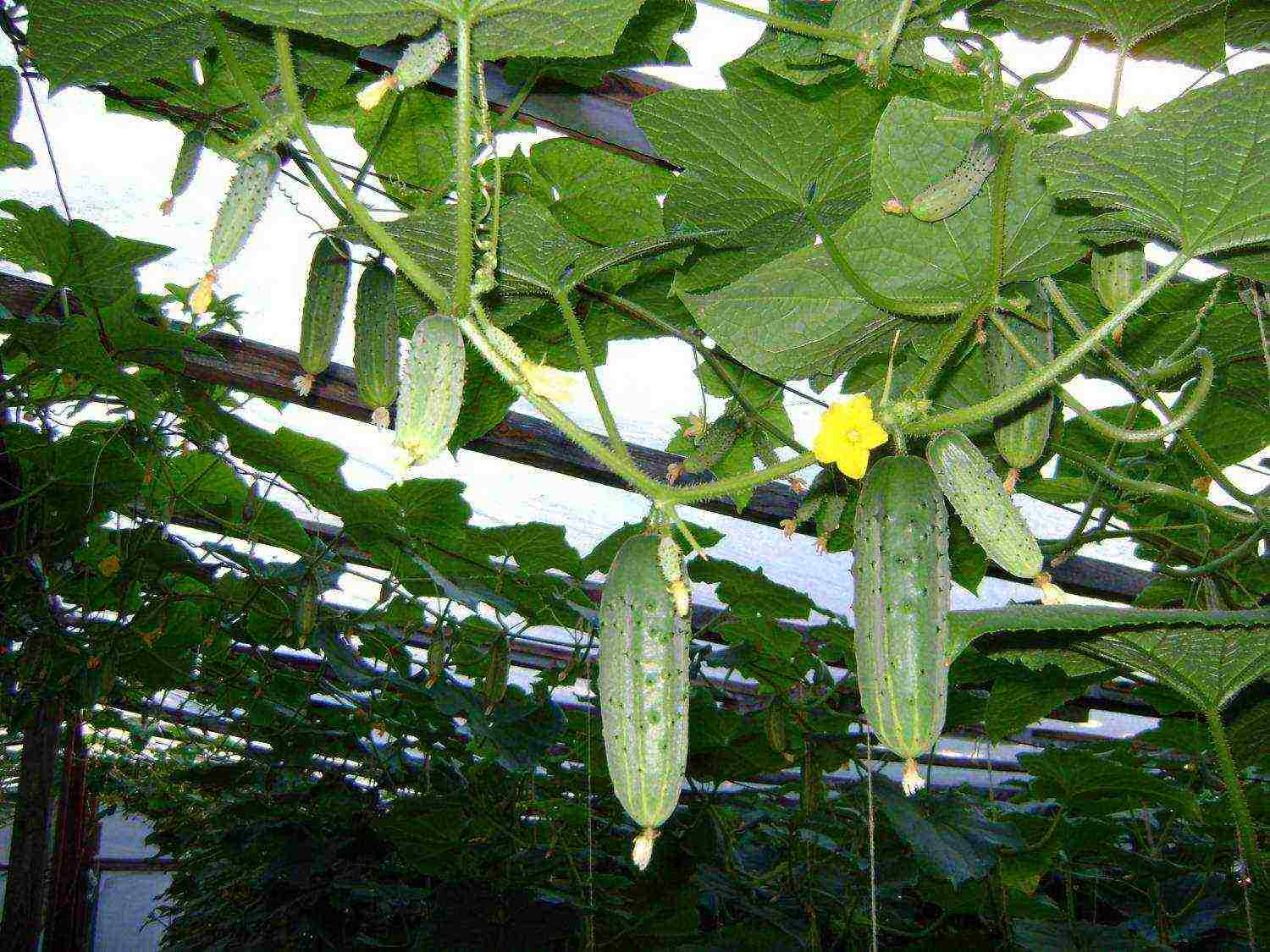
Cucumbers in the greenhouse
Variety selection
The correct choice of cucumber variety is very important, since it affects the harvest no less than proper care. Several decades ago, it was quite simple to understand the assortment of cucumber seeds - there were few of them, and the names of the varieties were familiar to every gardener. Currently, new varieties and hybrids appear annually; even experienced agronomists cannot remember all their characteristics.

Choosing a variety of cucumbers for growing in greenhouses
How to choose the right cucumber variety for greenhouse cultivation? What needs to be considered when doing this? Even a novice gardener understands that varieties intended for indoor use are suitable for greenhouses. At the same time, it is necessary to take into account a whole series of characteristics, which will be discussed below.
Variety or hybrid - what to choose?
Differences between varieties and hybrids are not clear to everyone. The main difference between varietal cucumbers is that their characteristics are inherited over several generations. Such cucumbers can be propagated with their own seeds, if the cross-pollination of the varieties is excluded. The price of varietal seeds is usually low, but in terms of fruit quality and growth rate, varieties can lose out to hybrids.

Benefits of varietal cucumbers
Hybrids marked with the F1 sign change their characteristic features already in the second generation. Their seeds are obtained as a result of long-term selection work, so it makes no sense to leave the fruits to get your seed. The yield of the second generation of hybrid cucumbers will be low, as will the commercial quality of the fruit.
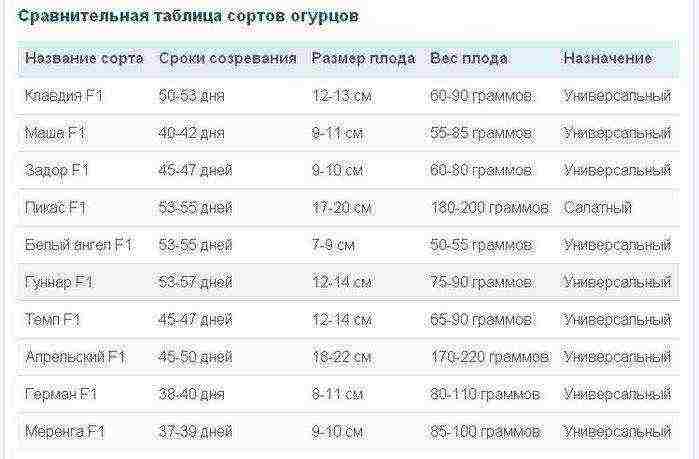
High-yielding cucumber hybrids

Varieties and hybrids of cucumbers
Due to the difficulty of obtaining hybrid seeds are several times more expensive than varietal ones, but the costs are justified - the hybrids reflect the best qualities of their "parents", which affect the yield and resistance of plants to unfavorable factors.
The advantages of hybrids include:
- early and long-term fruiting;
- high productivity;
- excellent taste and appearance of zelents;
- disease and pest resistance;
- resistance to temperature and humidity changes;
- shade tolerance;
- the formation of a compact bush.
In general, the yield of hybrid cucumbers when grown in a greenhouse is higher, which is important in a limited area. For this reason, experienced gardeners choose hybrids for greenhouses.
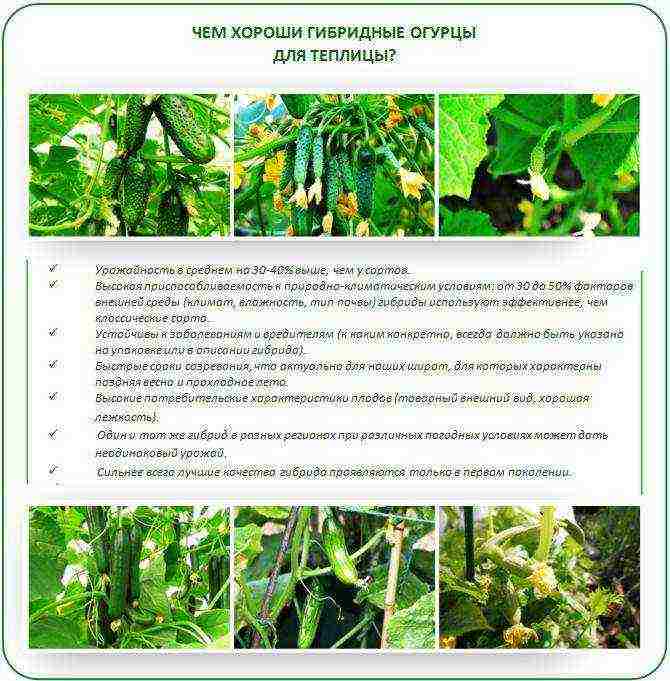
Benefits of hybrid cucumbers
Ripening terms
How soon you can eat the first cucumbers depends on this characteristic, in addition, the ripening period sometimes affects the duration of fruiting.
By the timing of the ripening of the first fruits, cucumbers are:
- early maturing (38-45 days);
- mid-season (45-50 days);
- late ripening (more than 50 days).
It is also necessary to take into account such a characteristic as early ripening - the ability to give a friendly harvest in the first two to three weeks of fruiting. Early ripening varieties of cucumbers are able to please with a bountiful harvest already 42-45 days after germination.
"Zozulya" - early ripening parthenocarpic variety of cucumbers
In order to get a stable harvest all summer, experienced gardeners plant several varieties with different ripening periods, for example, early ripening salad or universal cucumbers and mid-season pickling varieties. In southern regions with a long summer, late-ripening can be planted - by the beginning of active fruiting, they manage to gain a powerful green mass, therefore, they have a good harvest.
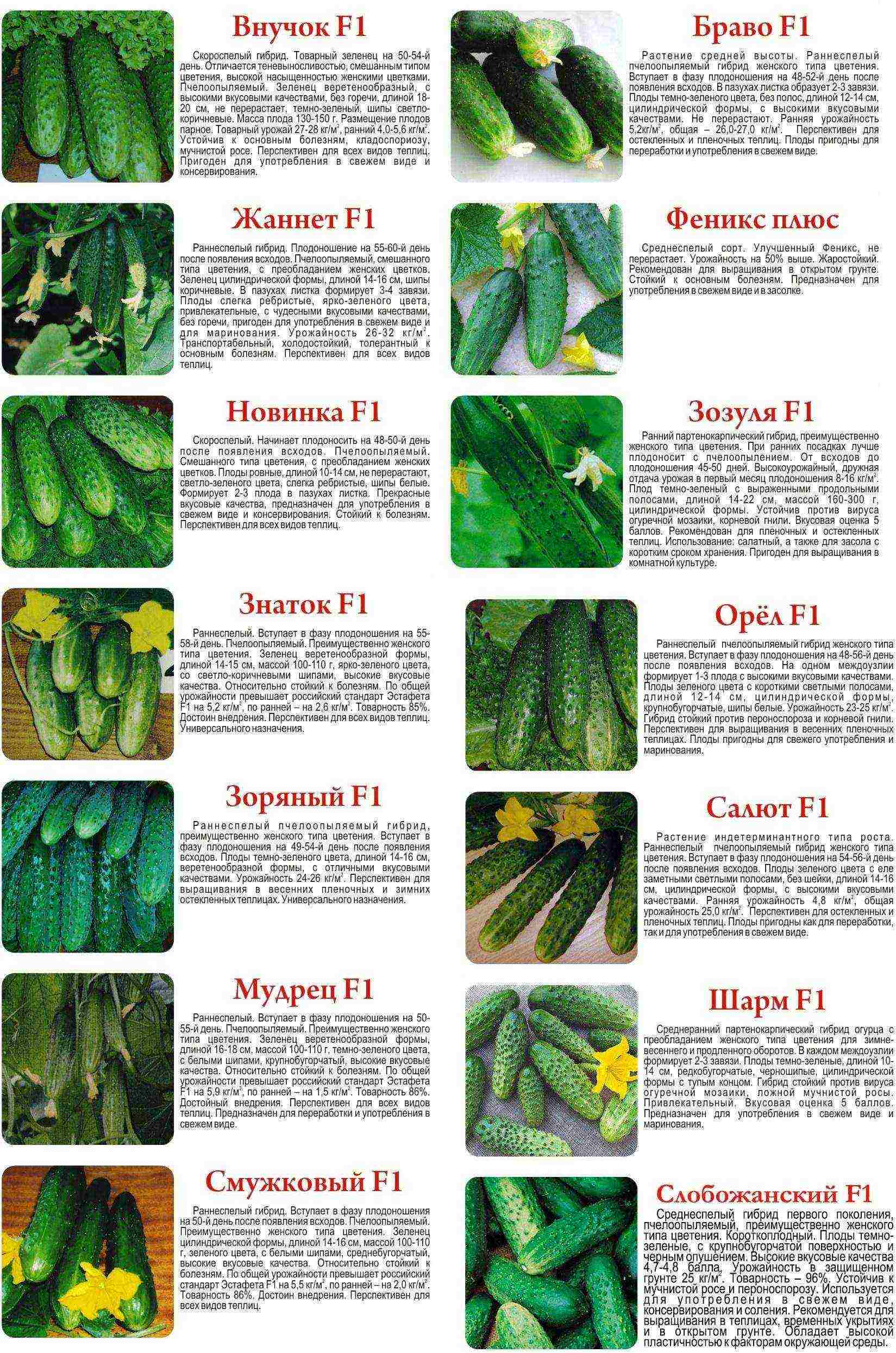
Greenhouse cucumber varieties
Pollination method
For the appearance of ovaries, it is necessary to provide the plants with the possibility of pollination. In the open field, there are no problems with this - bees, butterflies and other insects, flying from one plant to another, transfer pollen and pollinate female flowers. Providing insect access to the greenhouse is not always possible, especially when it comes to early vegetables.
For this reason, when choosing a variety or hybrid, you need to pay attention to the method of pollination - from this point of view, cucumbers are:
- bee-pollinated;
- self-pollinated;
- parthenocarpic.
For a successful ovary of bee-pollinated varieties in a greenhouse, it is necessary to use means for attracting insects - bait plants, fruit formation stimulants or sweet water. It is also necessary to open the vents daily and provide access to insects. In addition, for successful pollination, you need to plant cucumbers with a large number of male flowers to fruiting varieties.
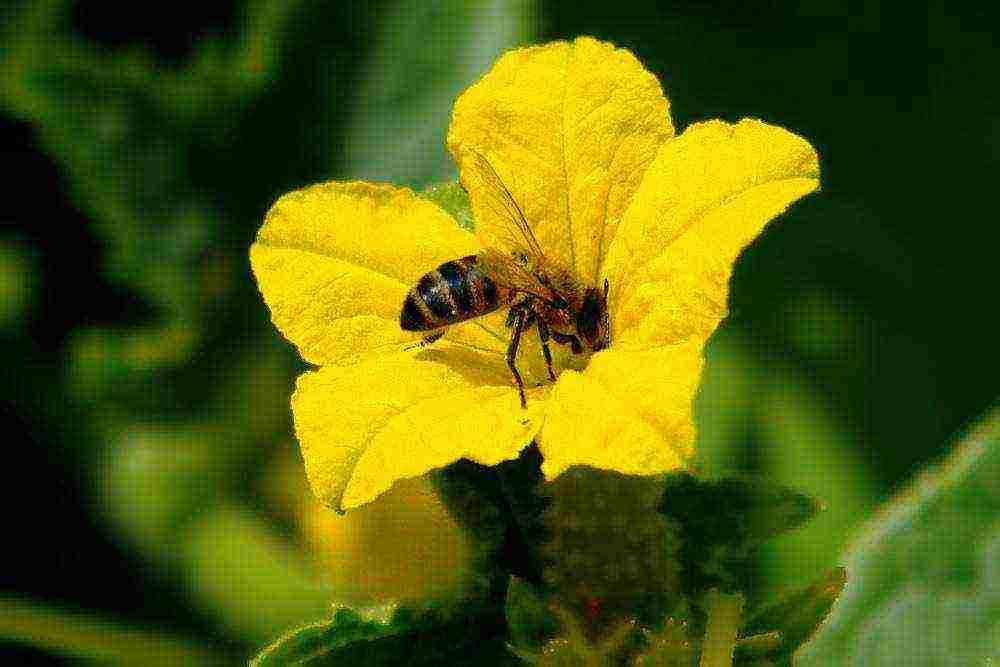
Bee-pollinated varieties
Self-pollinated varieties and hybrids do not require the participation of insects - each bush has both male and female flowers, and pollination occurs due to the transfer of pollen by air currents. In this case, stable air humidity and temperature are important.
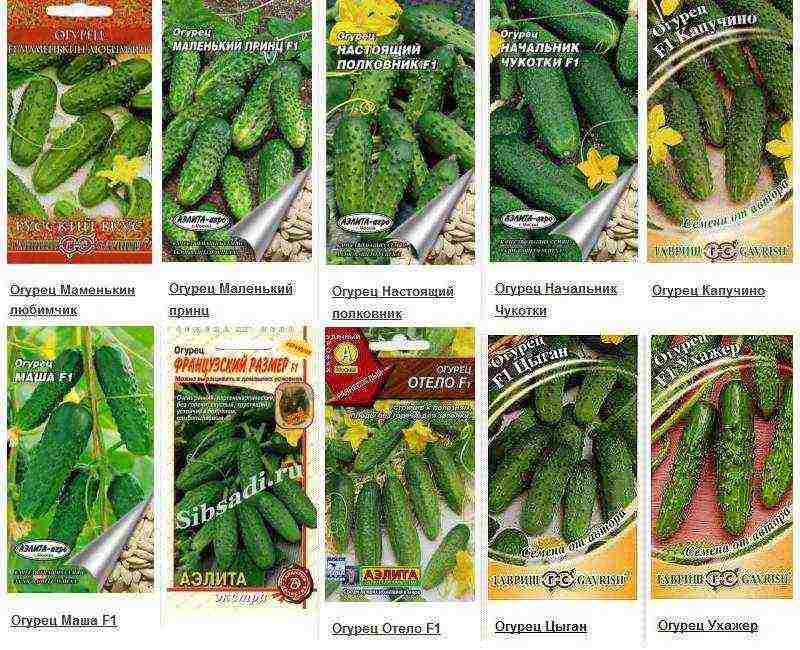
Self-pollinated cucumber varieties are perfect for short daylight hours
Parthenocarpic cucumbers do not have male flowers at all, the ovaries appear without pollination. They are best suited for growing cucumbers in difficult climatic conditions when it is impossible to maintain a stable temperature and humidity in the greenhouse, as well as open / close it daily.

Parthenocarpic hybrids
Purpose of fruits
Cucumbers can be eaten both fresh and in pickling, marinade, canned salads. The choice of this characteristic depends on your taste preference.
By appointment, cucumbers are:
- salting;
- salad;
- universal.
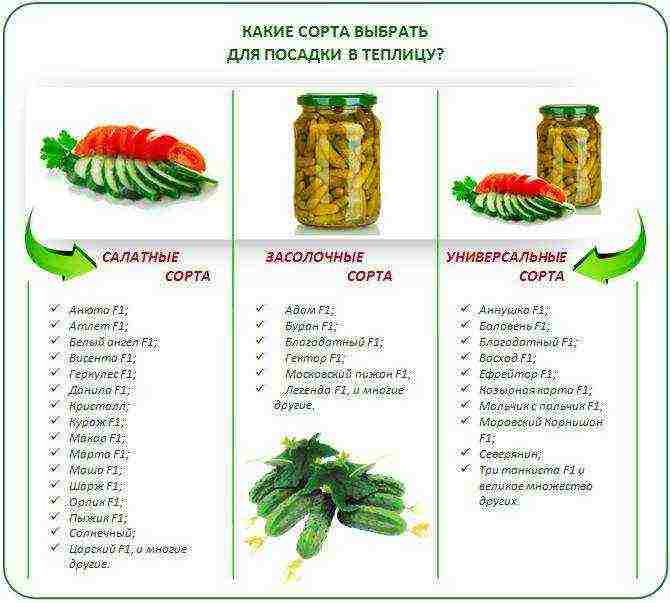
Appointment of different varieties of cucumbers
Pickled cucumbers are distinguished by a thin skin with large thorns and a significant amount of sugars. These qualities make it possible not only to put them tightly in jars, but also to ensure high-quality salting. Saline penetrates well through the thin skin, thanks to the sugars, rapid fermentation occurs and the formation of a preservative - lactic acid. Salted varieties reach a length of no more than 15 cm, after which they begin to grow in width with the formation of a coarse peel and large seeds.
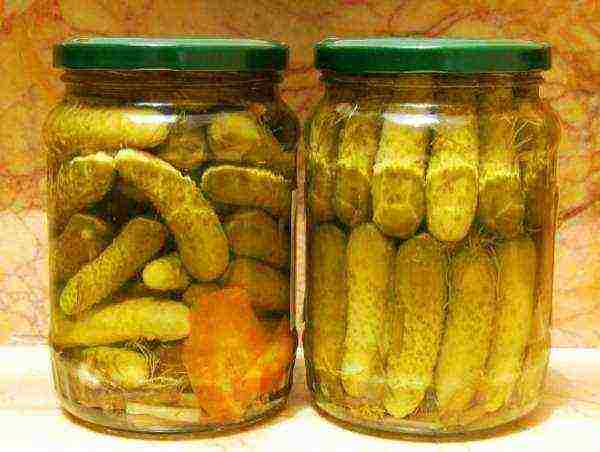
Pickled cucumbers
Salad cucumbers have a smoother skin, sometimes slightly bumpy. They have a more pronounced fresh aroma, an elongated shape and a light color of the thorns. Salad cucumbers can be up to 75 cm long (depending on the variety), while their flesh remains tender and the seeds are small. Multipurpose cucumbers can be used both for salads and for preparations - they have soft skin, juicy pulp and small seeds.
On a note! It is also important to pay attention to the size of the fruit of the selected variety. For pickling, pickles are used - greens ranging in size from 3 to 5 cm. For pickling, gherkins are ideal, the length of which is from 4 to 9 cm. Having reached the specified size, cucumbers of small-fruited varieties will begin to grow in breadth, turn yellow and coarse.
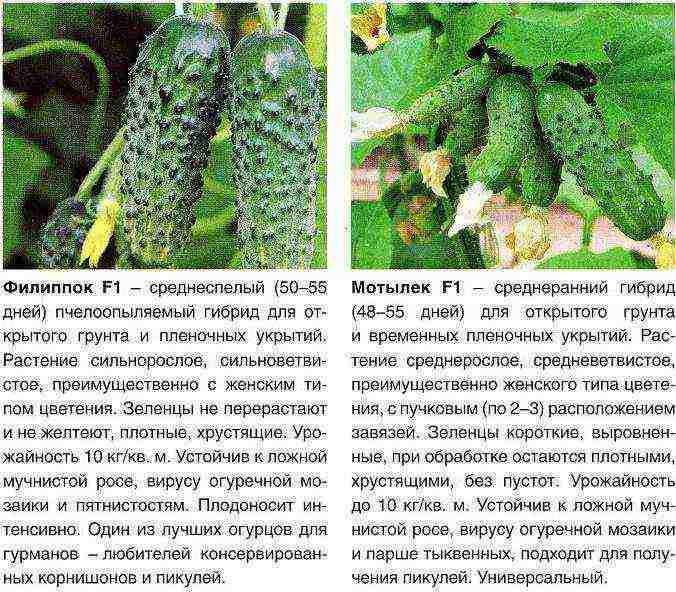
Varieties for obtaining gherkins and pickles
In addition to the listed characteristics, other features can be found in the description of varieties.
- Bouquet fruiting... It is usually found in parthenocarpic hybrids with small pickled fruits. The ovaries are located in the internodes in bundles of 5-7 pieces.
- Limited branching... Plants are distinguished by a powerful stem, lateral shoots are poorly formed. As a rule, this feature is characteristic of self-pollinated hybrids. It is convenient to grow such cucumbers vertically according to a thickened scheme.
- Shade tolerant... Cucumbers capable of producing a good harvest in a rainy summer or in an unfortunate location of a shade greenhouse.
- Male flowering type... These varieties are planted to bee-pollinated cucumbers with the female type of flowering as pollinators, they are not productive by themselves. Usually one pollinating cucumber bush is enough for 5 female plants.
Note! When choosing a variety, it is also important to consider the region for which it is recommended and the optimal planting time.
Soil preparation for seedlings
Cucumber seedlings are quite tender and capricious - they are susceptible to fungal diseases, they often stretch out and get sick. To grow strong seedlings, it is important to pick up loose and fertile soil that is treated against viral / fungal diseases and pests.
The easiest way is to buy ready-made soil mixture for seedlings from trusted manufacturers, but with large planting volumes, this requires a lot of money. Therefore, many summer residents prefer to prepare the soil on their own since the fall.

Soil components for cucumber seedlings - peat, sand, humus and sawdust
Possible options for the composition of the soil are shown in Table 1.
Table 1. Soil for growing cucumber seedlings.
| Peat soil. It has good nutritional and disinfecting properties. | Peat - 2 l; humus - 2 l; sawdust - 1 l; wood ash - 100 ml; complex mineral fertilizer for cucumbers - 1 tbsp. l. |
| Compost-based soil. Differs in high nutritional value and loose structure. Requires disinfection with heating or potassium permanganate solution. | Sod land - 2.5 l; compost - 2.5 l; wood ash - 100 ml; superphosphate - 10 g. |
| Peat-peat mixture. Suitable for the initial stage of growing seedlings, it has good moisture and air permeability. | Peat - 2 l; humus - 1 l; sod land - 1 l; sawdust - 1 l; complex fertilizer for cucumbers - 10 g. |
| Soil based on organic fertilizer. Differs in a high nitrogen content required in the initial phase of seedling growth. Requires disinfection with a solution of potassium permanganate. | Peat - 2.5 l; sawdust - 1 l; sand - 1 l; mullein - 0.5 l, wood ash - 2 tbsp. l. |
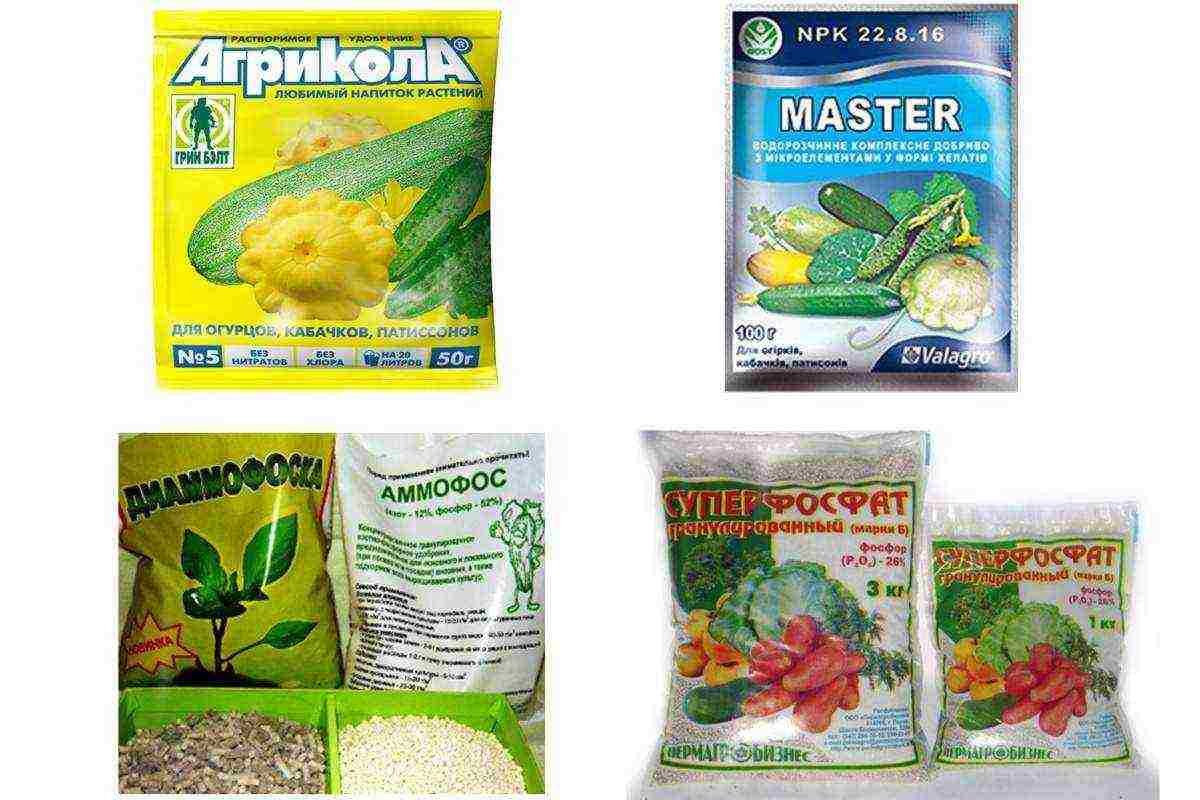
Fertilizers for the preparation of soil mixtures
All components taken in the indicated proportions are mixed. To get rid of pest larvae, a container with soil is exposed to frost for several days - at temperatures below -10 ° C, melon aphid larvae, spider mites and other insects die.
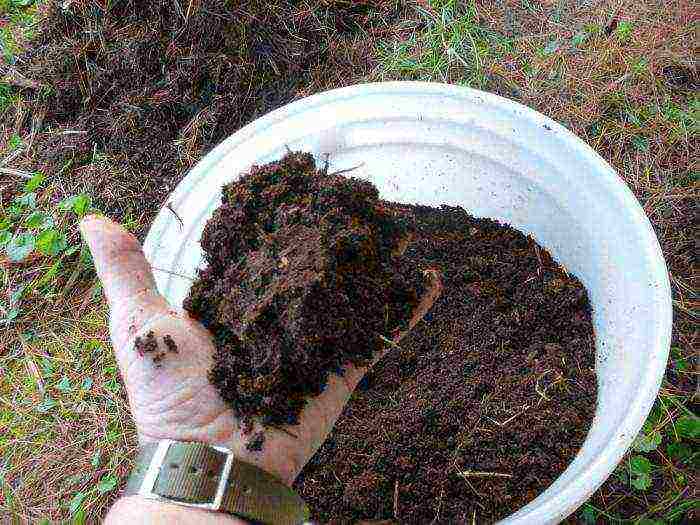
Mixing soil for seedlings
The soil can also be warmed up at a temperature of 80 ° C for an hour - this will not only destroy pests, but also relieve viral diseases. To exclude fungal diseases, the soil can be watered with "Fitosporin-M" or a saturated solution of potassium permanganate.
Important! If garden soil is used for the preparation of seedling soil, it must be taken from the ridges where cucumbers and other melons and gourds have not been grown for at least 3-4 years!
Seed preparation
Purchased cucumber seeds are usually sorted and pre-planted. You can recognize such seeds by their colored protective shell or the mark on the bag. They can be planted dry in moist soil. Seeds collected by yourself or purchased from an unverified manufacturer must be prepared before planting.
Step 1. Calibration. Seeds are scattered on a sheet of paper and manually rejected curves, shriveled, small and darkened. The remaining seeds are dipped in salt water (1 teaspoon in a glass of warm water) and left to soak for about an hour. The floating seeds are removed, the drowned ones are washed in a sieve under a moderate stream of water.
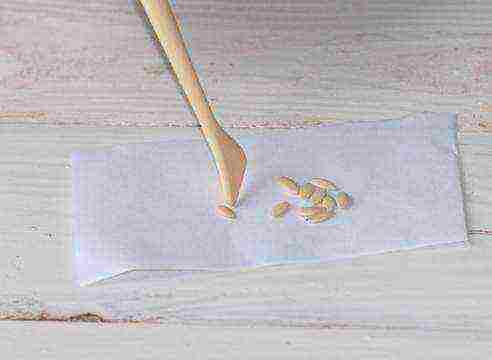
Seed calibration
Step 2. Disinfection. A solution of potassium permanganate of dark pink color is prepared and the seeds are immersed in it for 30 minutes, then washed with warm water. This treatment rid the seeds of bacterial infections.
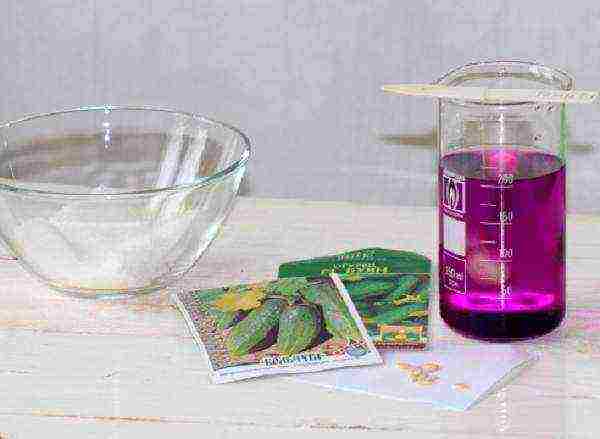
Potassium permanganate treatment
Step 3. Treatment for fungal rot. Prepare a solution of "Fitosporin-M" according to the recommendation on the package. The washed seeds are immersed in it for 3 hours. Rinse with warm water.
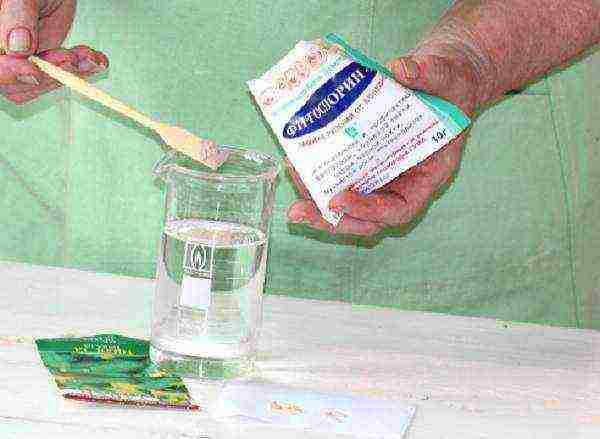
Seed treatment in solution "Fitosporin-M"
Step 4. Warming up.After processing, the seeds are dried, folded into a gauze or paper bag and placed for several days in a warm place - on a radiator or oven. The temperature should not exceed 65 ° C. You can also warm the seeds in a wet way - in a thermos with water at 55-60 ° C for an hour. Warming up increases the number of female flowers on cucumbers, in addition, prevents the occurrence of viral diseases.
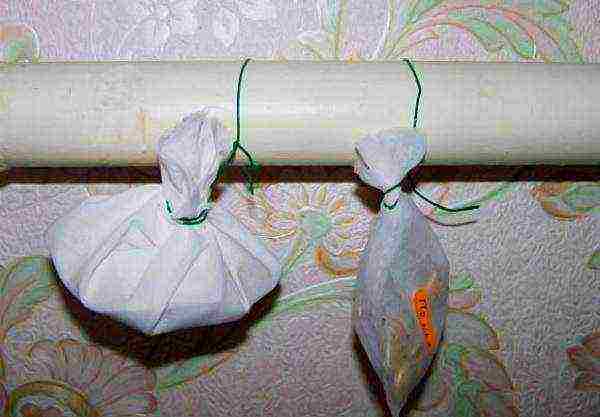
Heating seeds on the battery
Step 5. Hardening. Hardened seeds withstand temperature changes better, watering with cold water, drafts. Quenching is carried out in a refrigerator on the lower shelf, providing a temperature there of about 2 ° C. The seeds are placed on a paper or cloth napkin laid on a saucer, lightly poured with water and wrapped. Put in the refrigerator for a day.
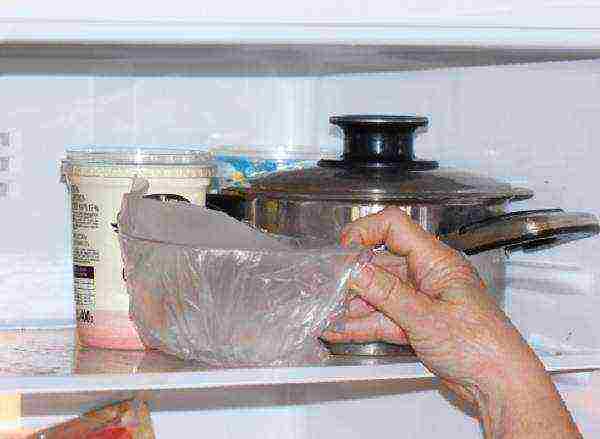
Seed hardening
Step 6. Treatment with growth stimulants. Stimulants include purchased formulations "Epin" or "Zircon", as well as the juice of a home plant aloe. Chemical stimulants are diluted according to the instructions and the seeds are soaked in the solution. Aloe juice is squeezed through cheesecloth, poured over the seeds and left overnight, covered with a napkin.
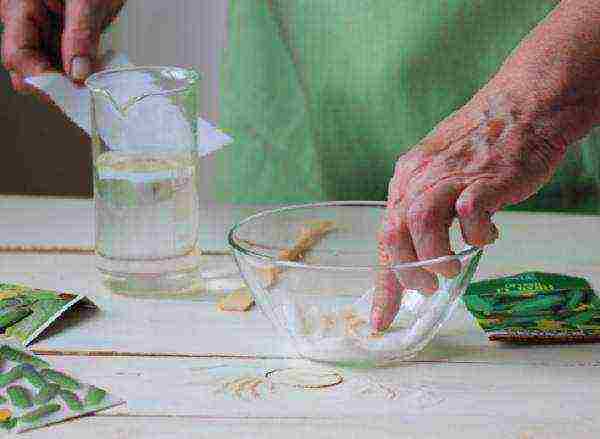
Stimulation of seeds in "Epin"
Step 7. Germination. This measure helps to reject non-viable seeds and accelerate the emergence of sprouts. For germination, a thick cloth napkin is required. Seeds are placed on it immediately after stimulation, lightly sprinkled with water and removed to a warm place. After 24-72 hours, the seeds are pecked.
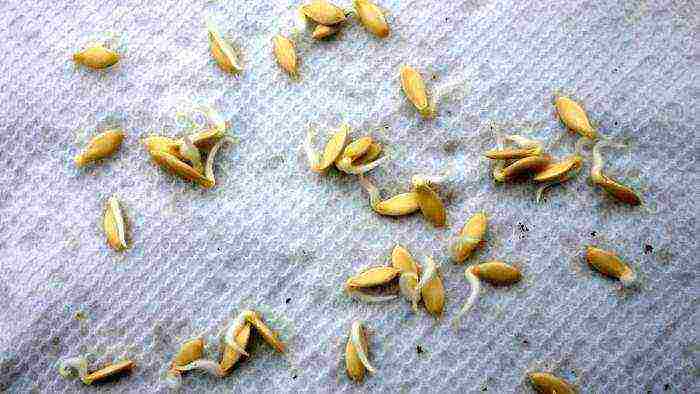
Germinating seeds
Note! For rapid germination, cucumber seeds need a temperature of 28-32 ° C. Make sure that the napkin does not dry out!
Sowing and growing seedlings
Seedlings of cucumbers are grown in cups with a height to width ratio of 2: 1 - cucumbers have a long taproot, in addition, if the seedlings stretch out, soil addition will be necessary. The optimal volume of cups is from 200 to 350 ml.
Step 1. Preparing seedling glasses. The cups are washed and rinsed with a solution of potassium permanganate. Fill 2/3 with the prepared soil mixture, lightly crush it with your hand. Pour with warm, settled water and leave for 3-4 hours so that the moisture is evenly distributed.
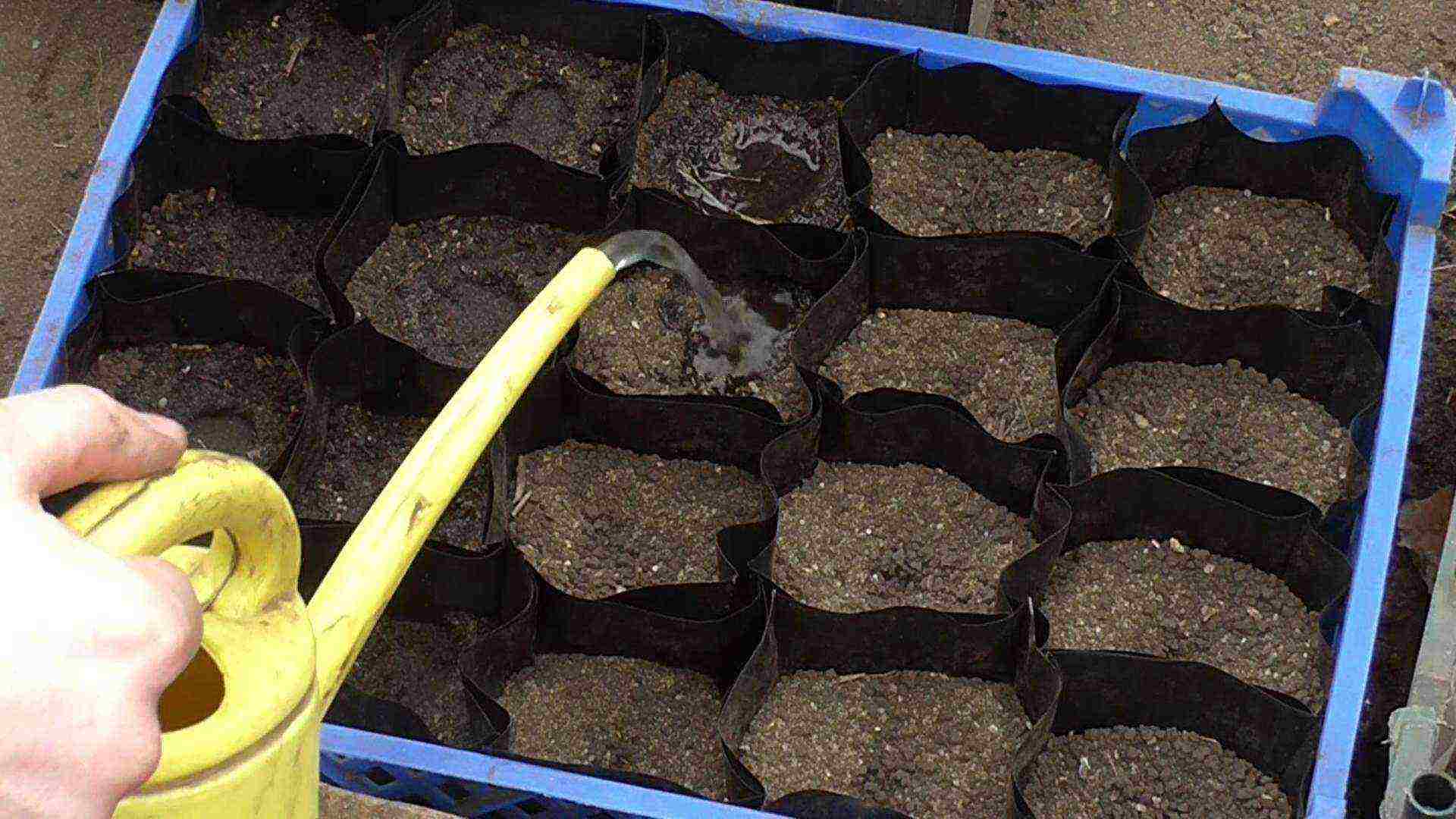
Filling cups with soil and watering
Step 2. Planting seeds. Gently pick up the seeds that have been picked up with your hands or with tweezers, being careful not to damage the root. With a pencil or a wooden stick, a 1.5-2 cm depression is made in the soil and the seed is lowered there with the root down. Carefully fill the hole with dry soil mixture.
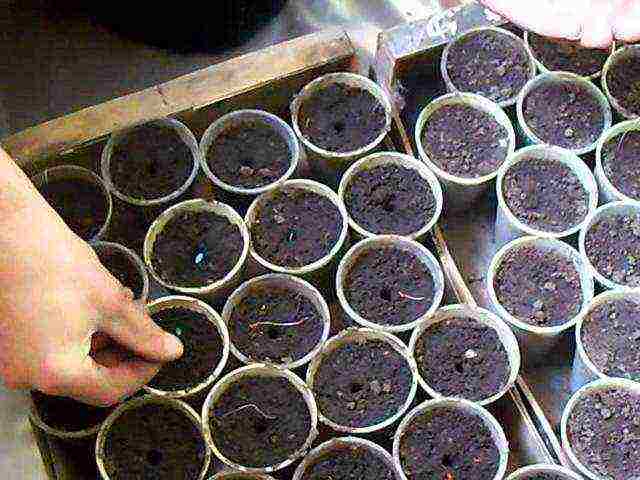
Planting seeds
Step 3. Germination. The cups are placed in a warm place, covered with glass or a transparent bag. They are examined daily, and when shoots appear, they are transferred to a well-lit place. If the sprouts are elongated, after the cotyledons have opened, the soil is carefully poured over the very leaves. After filling, the soil is gently watered with warm water.
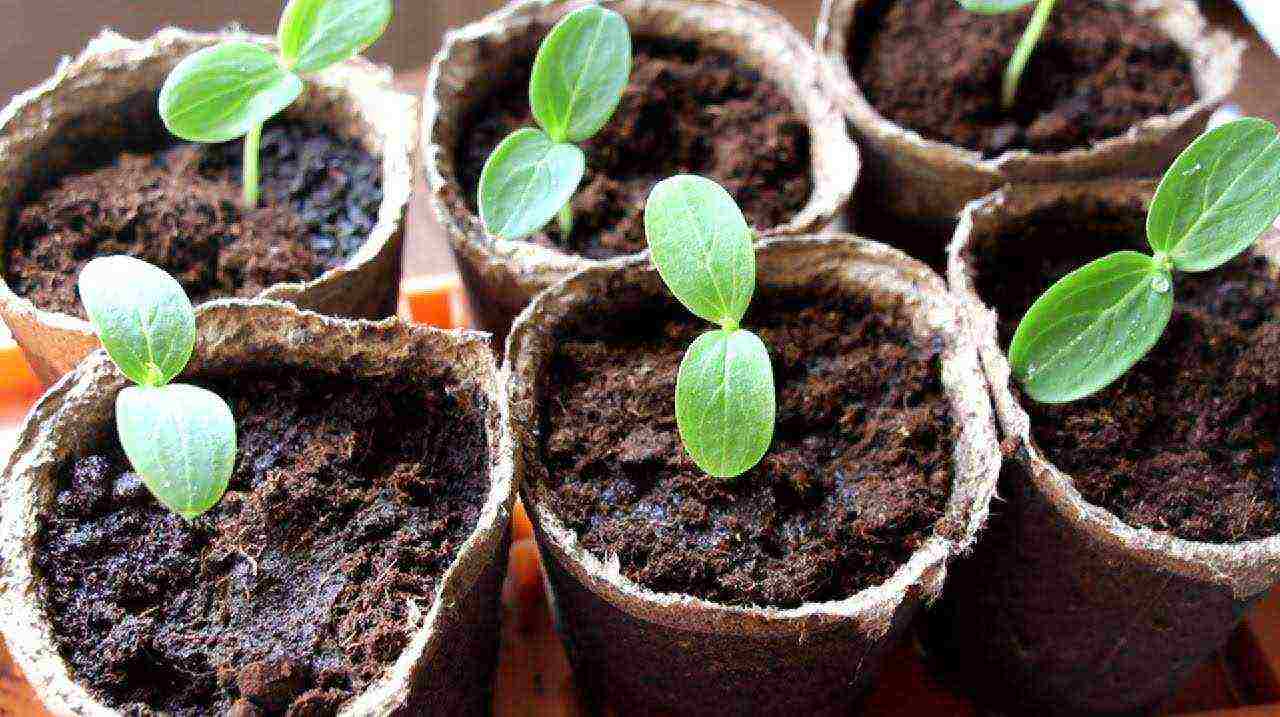
Cucumber sprouts
Step 4. Backlight. If there is not enough light on the windowsill, you need to organize backlighting using fluorescent lamps or special phytolamps.
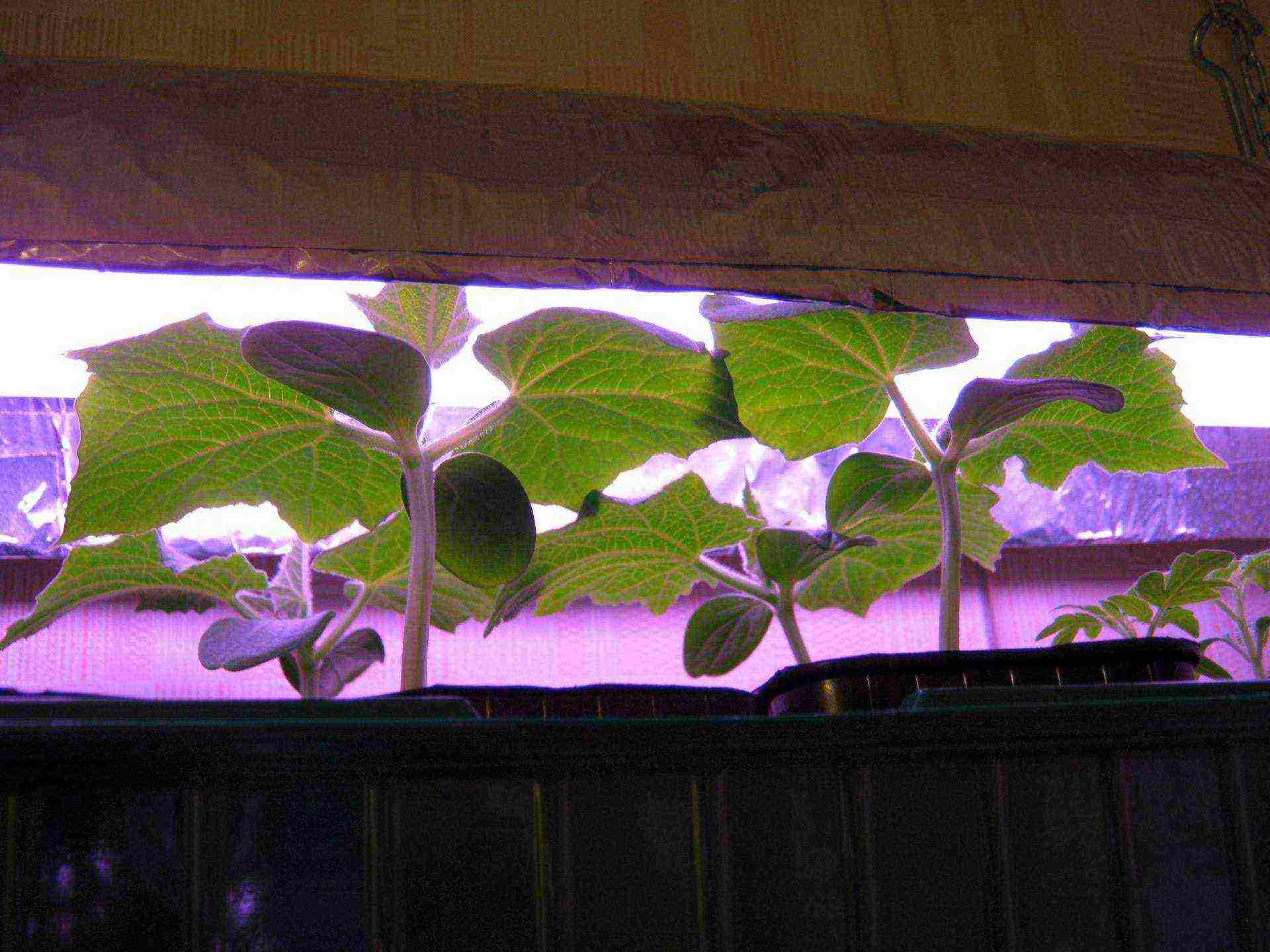
Lighting cucumbers
Step 5. Watering and fertilizing. Water the seedlings of cucumbers as the soil dries up, while it is impossible to pour or overdry the earthen lump. With each watering, you can add several grains of complex mineral fertilizer. If watering is carried out with ordinary water, then it is necessary to apply a complex fertilizer after the appearance of two true leaves. Sometimes plants do not have enough nitrogen - a signal of this is the yellowing of the cotyledons and lower leaves. If so, the seedlings must be watered with a urea solution.
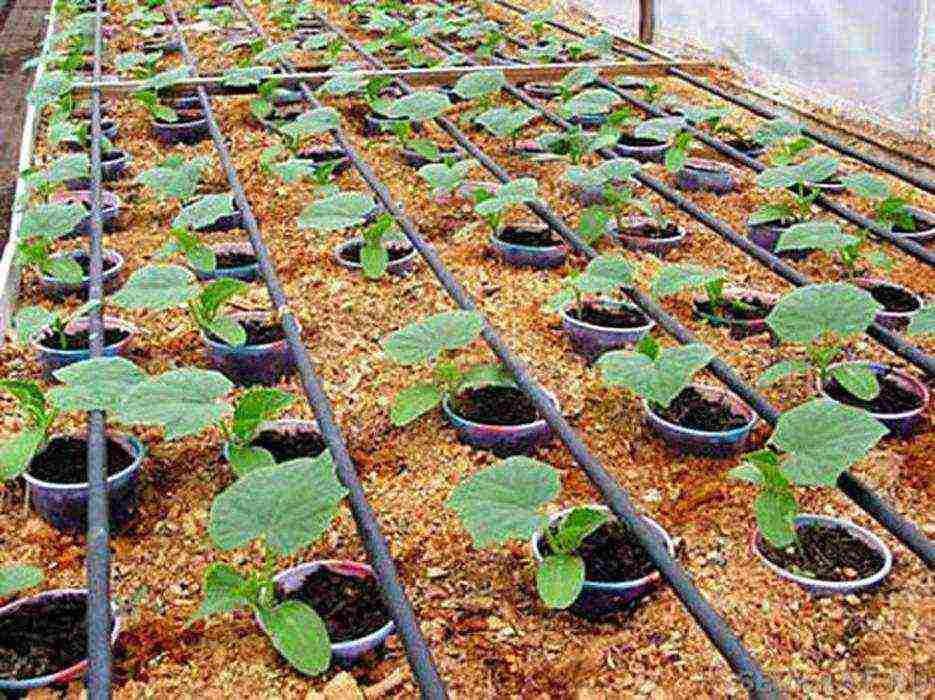
Drip irrigation of cucumber seedlings
Note! Cucumber seedlings are grown for 18-25 days. More mature seedlings take root less well, shedding ovaries and flowers. If the cucumbers become cramped in the pot, it is necessary to transplant the plants into a larger container.
Hardening and planting seedlings in a greenhouse
A few days before planting, when the temperature in the greenhouse rises to + 20 ° C, and the soil warms up to + 15 ° C, the plants begin to prepare for planting. Every day they are taken out to the greenhouse for 3-4 hours, in the first days they are shaded from the sun with the help of a newspaper or dense covering material. When the plants adapt to the conditions of the greenhouse, you can start planting seedlings.
Step 1. Well preparation. Planting holes are prepared: they take out the earth on the bayonet of a shovel and fill them with a mixture similar in composition to the seedling soil. The distance between the holes depends on the variety and is usually 30-50 cm in a row and 60-70 cm between rows. Complex fertilizer or superphosphate is added to each well. Watered with warm water or a weak solution of potassium permanganate so that the earth settles.
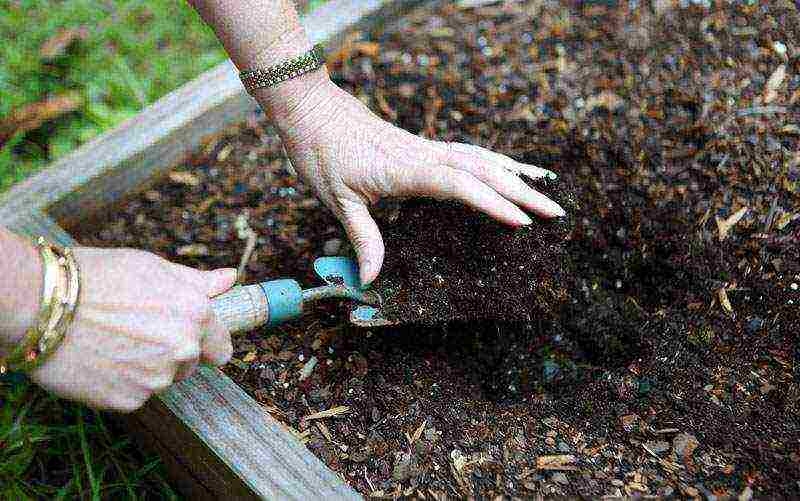
Preparing holes for planting
Step 2. Removing seedlings from pots. Seedlings in pots are watered abundantly for an hour or two before planting, so that the earthen lump lags well behind the walls. They put their hand on the glass so that the stem of the plant is between the fingers, turn it upside down and lightly tap on it. The lump usually comes out easily, if not, they gently pry it along the edge of the walls of the pot. You cannot pull on the stem - it may break.
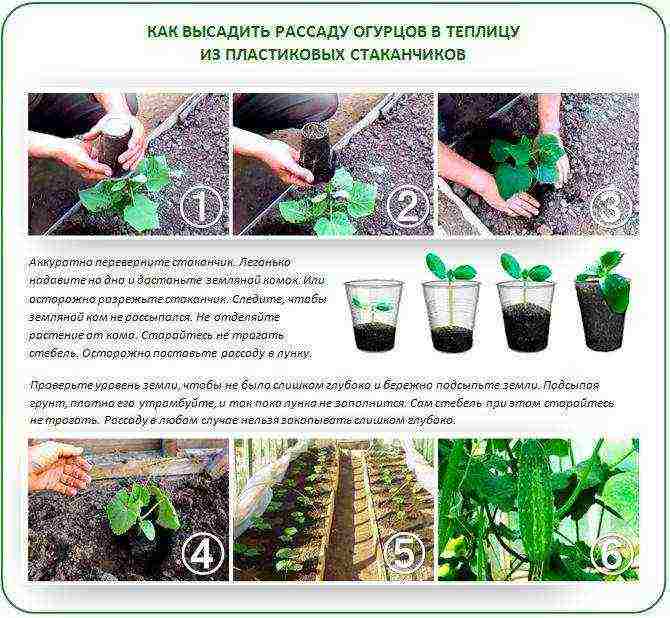
Transplanting
Step 3. Planting seedlings. A plant with an earthen lump is placed in the hole, if necessary, deepening to the cotyledonous leaves. Gently sprinkle it with earth and compact it, sprinkle it moderately with warm water.
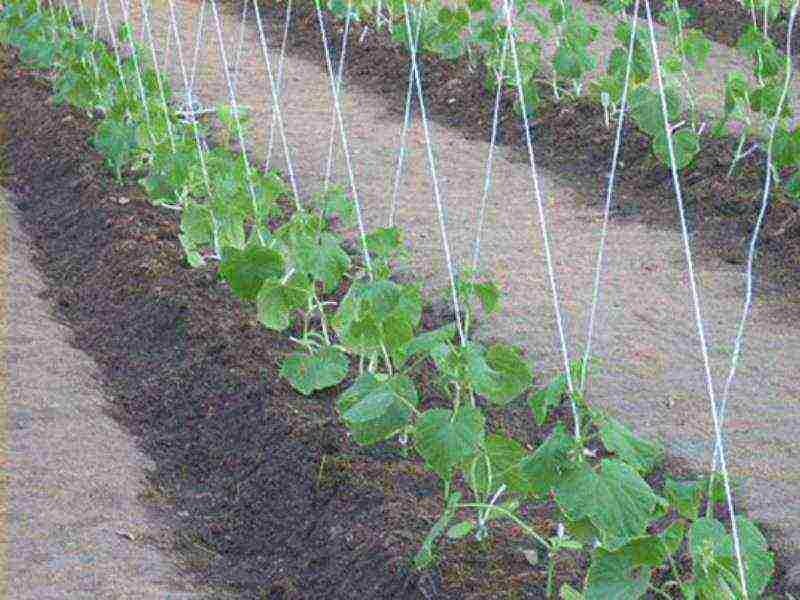
Cucumbers after disembarkation
Note! Seedlings must be protected from bright sun or possible hypothermia with a covering material or light paper.
Greenhouse cucumber care
Cucumbers will grow rapidly and actively bear fruit only if the rules for caring for them are observed. It is not difficult to create the desired regime in the greenhouse, the main thing is to know the needs of this culture and the features of agricultural technology.
Temperature regime
Cucumbers are thermophilic crops. With a slight decrease in temperature, they stop the growth and fruit setting, and get sick with fungal rot. When the temperature rises, the plants shed their ovaries and fruits. The optimum temperature in all phases of the growing season is shown in the figure.
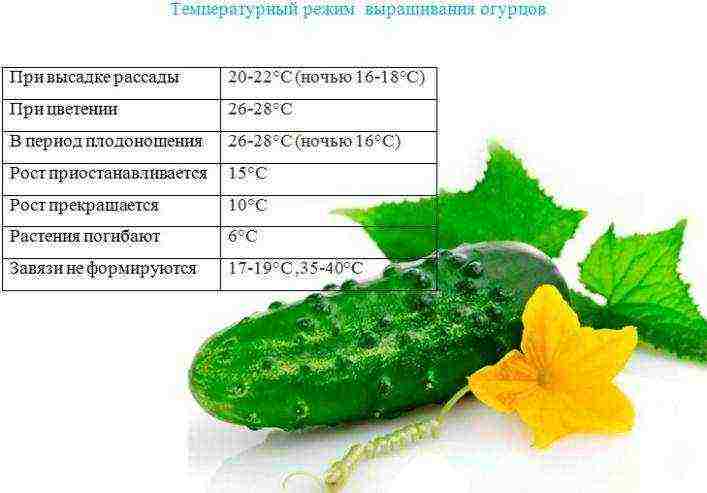
Temperature conditions for growing cucumbers
They regulate the temperature with the help of ventilation: on hot days, open the vents located in the upper part of the greenhouse. Cucumbers do not like cold drafts, therefore, doors can be opened for airing only from the south side and in very hot weather.
Humidity during the entire growing period should be in the range of 70-85%. You can maintain sufficient humidity on hot days by installing a container with water in the greenhouse, from where the moisture will evaporate evenly in the heat. In addition, the water in the barrel is a heat accumulator - heating up during the day, it gradually cools down at night, smoothing out temperature drops.
Note! You can add organic fertilizer and grass to the barrel. After fermenting, they will provide a stable release of carbon dioxide, which is necessary for photosynthesis. Fermented solution is an excellent concentrated fertilizer.
Watering and fertilizing
Cucumbers love evenly moist soil. The best irrigation regime is drip, when water regularly flows directly to the roots of plants, without falling on the leaves and stems.
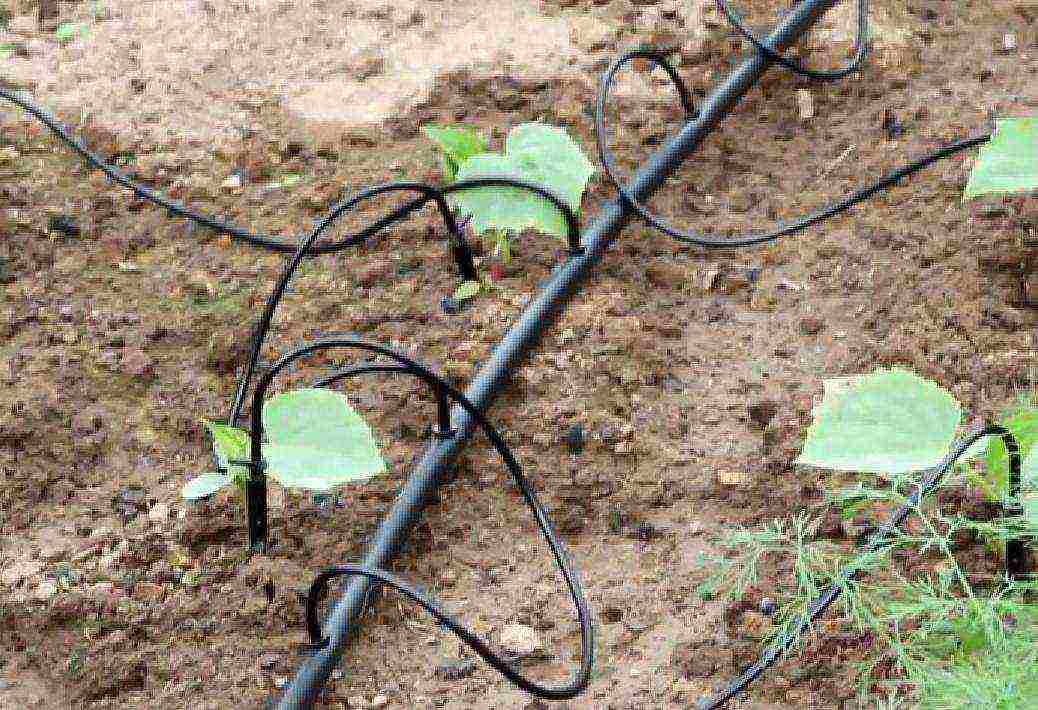
Drip irrigation of cucumbers in the greenhouse
Cucumbers can also be watered with a watering can under the root, while it is necessary to use a diffuser so as not to cause erosion of the soil and exposing the roots.
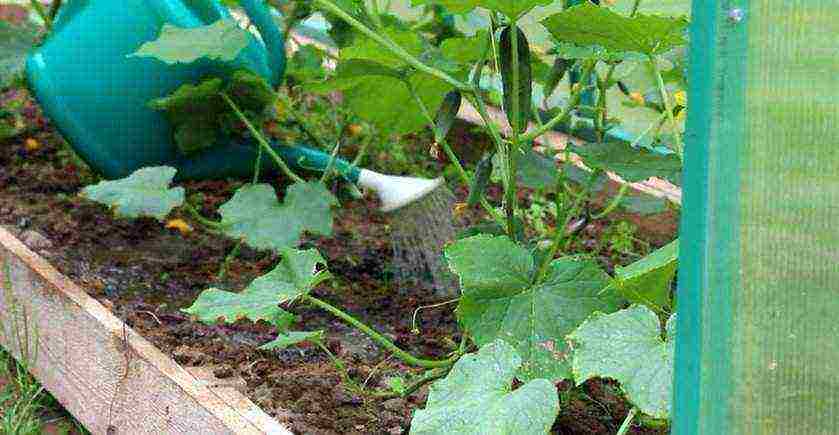
Watering cucumbers from a watering can
The water temperature for irrigation should be + 25-28 degrees. When watering with cold water, the risk of bacterial and fungal diseases increases sharply, weakened plants do not resist the attack of pests poorly. In addition, when watered with cold water, cucumbers begin to taste bitter.
In hot weather, cucumbers are watered daily, in the early morning hours or immediately after sunset. In cloudy weather, watering can be reduced to 2-3 times a week.
Cucumbers are very responsive to organic fertilizing.As a fertilizer, you can use infusions of mullein (1:10), bird droppings (1:25), nettle (1: 5) or tomato tops and stepchildren (1:10). Organic matter is placed in a barrel, wood ash is added (2 cups per 50 l) and left for several days, waiting for the end of fermentation and clarification of the infusion. The resulting infusion is poured over the root cucumbers immediately after watering.
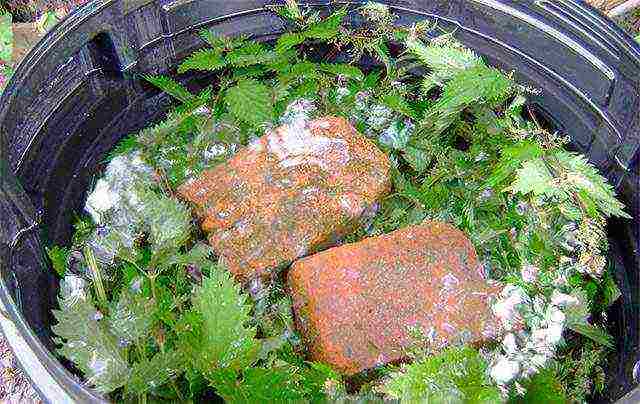
Nettle infusion for feeding cucumbers
Cucumbers also need regular micronutrient feeding. Such dressings are usually made foliar - they dilute the fertilizer in water and spray the leaves. This method allows you to reduce the consumption of the solution and deliver the necessary substances to all parts of the plants.
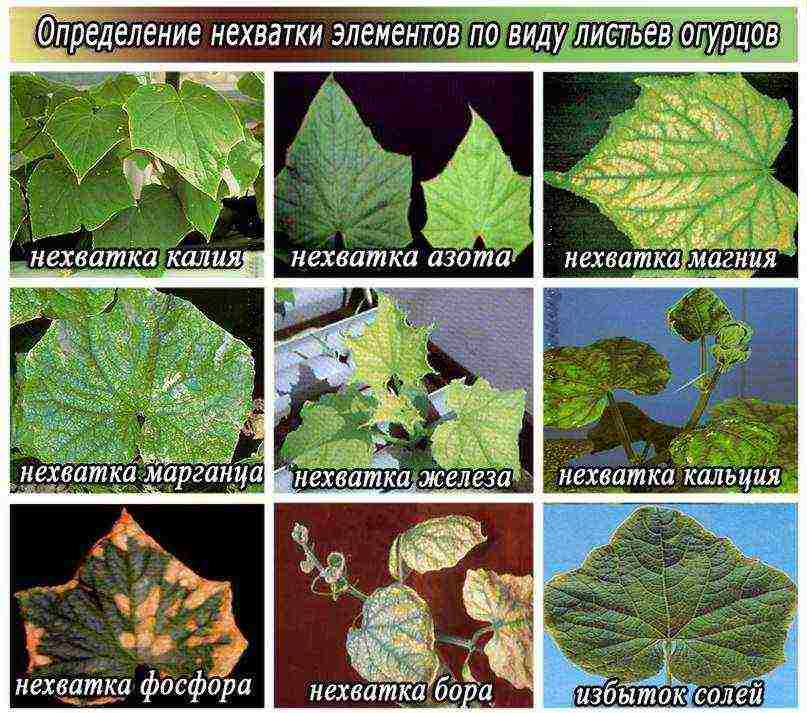
Impact of micronutrient deficiencies on cucumbers
Top dressing and spraying usually alternate, the interval between them is 5-7 days. The scheme of feeding and preventive treatments is shown in the figure.
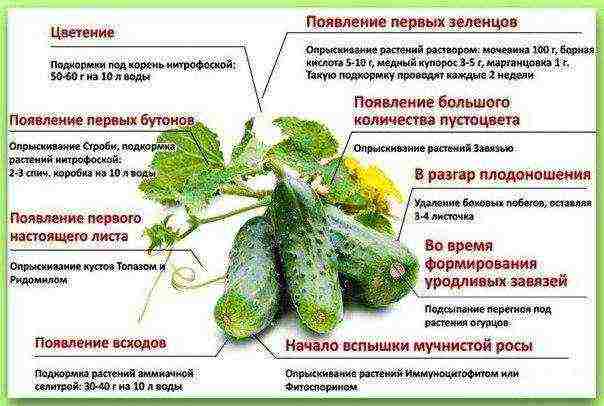
An approximate scheme for the introduction of dressings and the prevention of diseases
Weeding, loosening and mulching
Weeds in the greenhouse must be removed regularly. They not only take away nutrients from plants, but also often serve as bait for insect pests. It is more convenient to water the beds a few hours after watering - at this time the soil is loose, soft, and the weeds are easily pulled out by the roots.
Weeding is combined with loosening to a depth of 5 cm; it is not recommended to loosen the cucumbers deeper, as the roots can be damaged. To reduce moisture evaporation, as well as drown out the growth of weeds, the soil under the cucumbers is mulched with peat, rotted sawdust, wood shavings, and straw.

Mulching cucumbers with straw
Note! It is not recommended to cover the soil with a film - slugs will settle under such a cover, causing great harm to cucumbers.
Forming and tying bushes
Cucumbers do not tolerate thickening, so it is necessary to correctly form the bushes by removing or pinching off excess shoots. The molding scheme depends on the type of cucumber.
Bee-pollinated varieties of medium and late fruiting periods give the maximum number of ovaries on lateral shoots. When they are formed, 3-4 lower lateral shoots are blinded, one ovary is left on the next 3-4 shoots, two ovaries are left in the middle of the stem, and three or four fruits are on the upper shoots. The main stem is thrown over the trellis and after a while pinched.
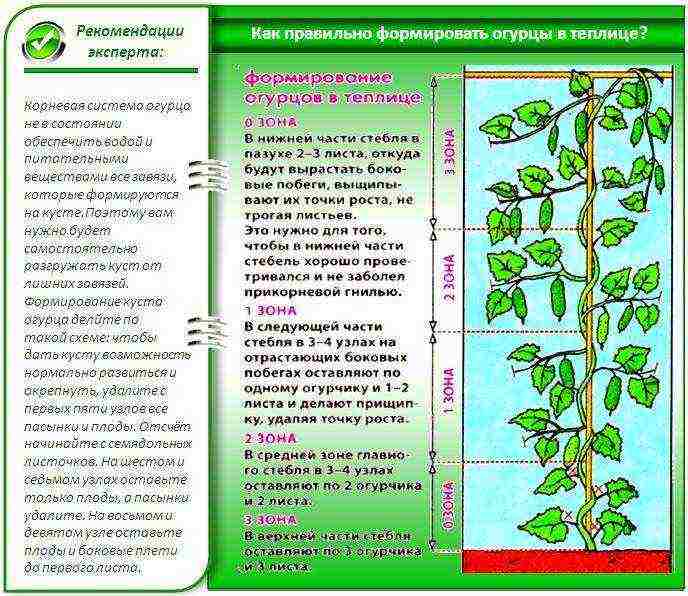
Formation of bee-pollinated varieties
Self-pollinated cucumbers with bouquet fruiting are formed according to a different scheme. The lower four lateral shoots are also blinded, one internode is left on the rest. The main stem is tied to the upper trellis and pinched so as to prevent thickening. On the upper branches, you can leave 2-3 ovaries.
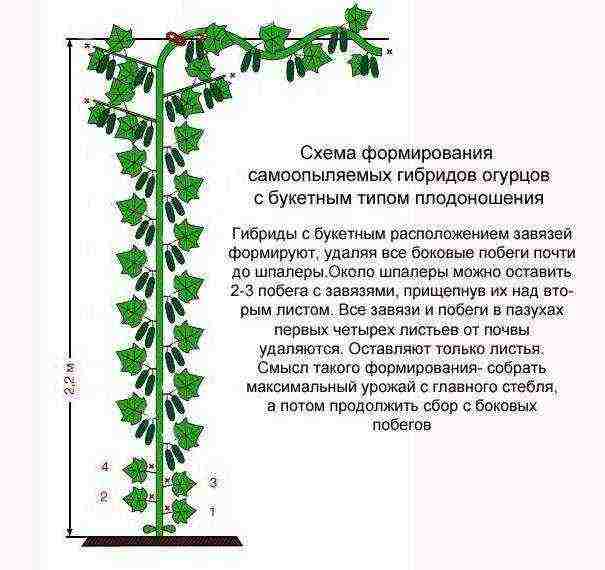
Formation of cucumbers with a bouquet type of fruiting
When forming cucumber bushes, it is also important to take into account the peculiarities of the greenhouse. With a low roof, such a molding scheme is recommended: on the side shoots above 5-6 knots, two ovaries are left, the main stem is pinched when it reaches the upper trellis and two upper side shoots are left, allowing them to hang down. Pinch as it grows, preventing thickening of the plantings.
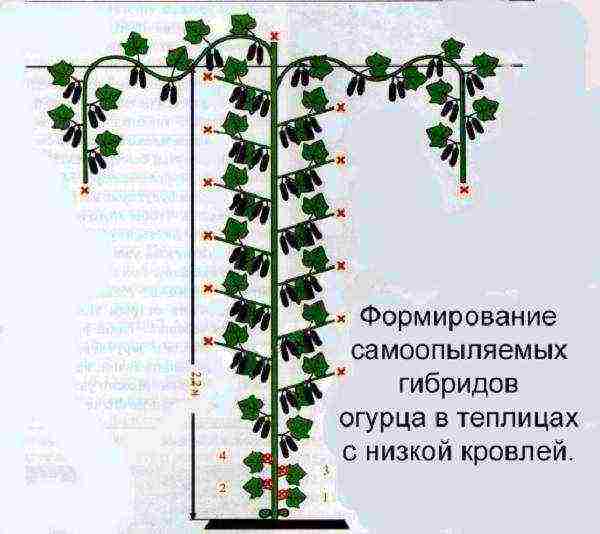
Formation of cucumbers in greenhouses with a low roof
Note! It is better to tie cucumbers with a soft cloth tape, the twine cuts into delicate stems, creating conditions for the development of diseases.
Harvesting
The pledge of abundant fruiting of cucumbers is a timely harvest. Collecting greens of salad varieties is carried out at least once every two days, small-fruited and pickling - every day. Pickles can be harvested twice a day. Such a fruit collection schedule will allow the plant to devote maximum energy to the formation of new ovaries.

Fruit picking
The collection is carried out in the morning, until the cucumbers have lost their elasticity and juiciness. It is recommended to cut off the tails of the fruit with a sharp knife or scissors, but most gardeners will pick off the fruit.This must be done carefully, with one hand breaking off the fruit, with the other holding the stem so as not to break it.
Note! Even one missed cucumber dramatically inhibits the growth of the bush and the formation of new ovaries. You need to pick the fruits carefully, examining the bushes from all sides.
Potential diseases and growing problems
With proper cultivation of the soil in the greenhouse, planting material, as well as with proper care, most of the diseases typical for cucumbers can be avoided. However, even experienced gardeners are faced with the latter.
How to distinguish disease from pest damage and the consequences of improper care? The easiest way to use a classifier is to compare plant damage with images.
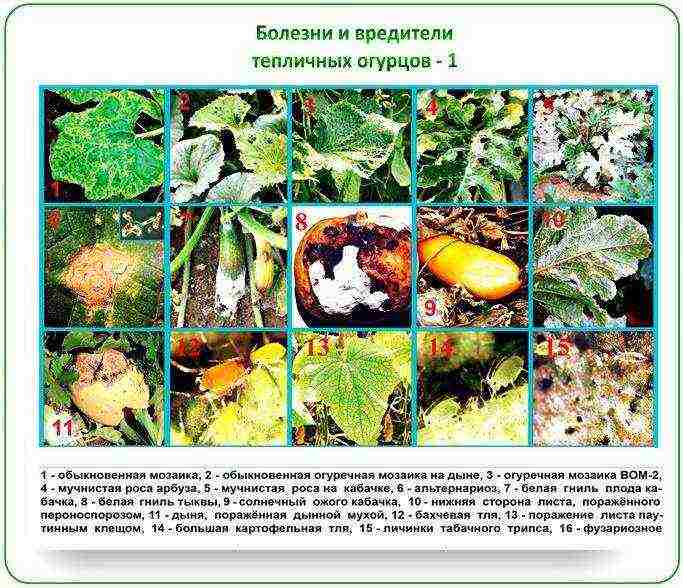
Diseases and pests of greenhouse cucumbers (part 1)
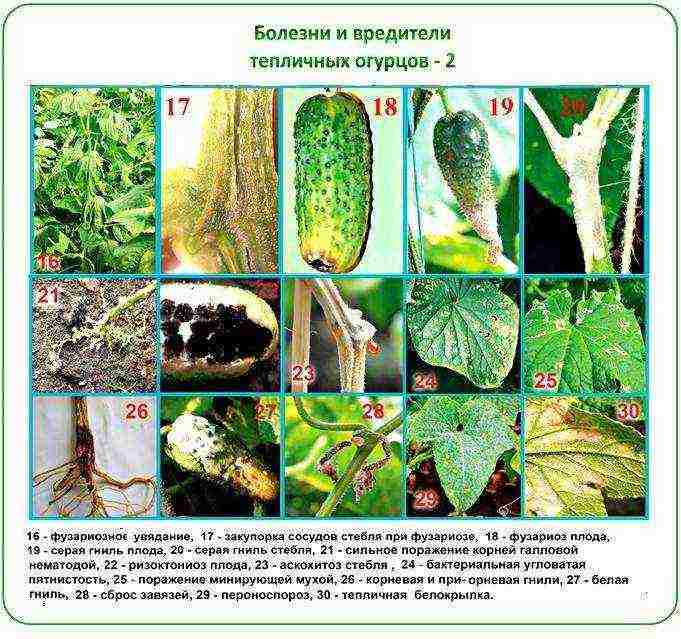
Diseases and pests of greenhouse cucumbers (part 2)
General methods of dealing with diseases of cucumbers and their pests:
- when viral diseases are detected, the plants are removed from the summer cottage or burned, the greenhouse is subjected to enhanced processing;
- in case of infection with a fungus, the damaged parts of the plant are removed, after which they are treated three times with fungicides with an interval of 5-10 days;
- treatment with solutions of manganese, iodine, and also copper-containing preparations helps against bacterial rot;
- sucking and gnawing pests are exterminated using systemic insecticides;
- slugs are fought with the help of ash or eggshells scattered on the soil, as well as chemicals intended for this.
Do-it-yourself greenhouse for cucumbers
This vegetable is picky about growing conditions and gives a good harvest only at a stable air and soil temperature. Providing cucumbers with the desired microclimate is quite simple: you need to install a capital or seasonal greenhouse in the garden.
Video - Diseases and pests of cucumbers: how to fight?
With the right choice of variety and proper care, cucumbers in a greenhouse give a good harvest even in cold and rainy summers. Fruiting can last until the very frost, if preventive treatments against pests and diseases are carried out in time.
Growing cucumbers in a greenhouse is an undertaking that requires a lot of effort and expense. But profitability is more than offset by early and bountiful harvests. Greenhouse conditions require a completely different attitude to plants than open ground. And here you need to produce care that is ideal for cucumbers.
It is important to consider the properties and characteristics of plants, even in a process such as watering. The same amount of water can be optimal for one type of plant, and almost fatal for another. A novice vegetable grower must know that growing cucumbers in a greenhouse involves a careful selection of the following factors:
- the correct choice of a place for a greenhouse and an advantageous location of the beds in it;
- competent soil preparation;
- the choice of the variety of cucumbers that best reflects your needs;
- correct planting or sowing;
- competent care of plants;
- the formation of the most fruitful bushes;
- the necessary knowledge to deal with possible diseases and pests.
Greenhouse placement and arrangement
Before talking about how to plant beds in a greenhouse, you need to say about him. This structure must stand firmly on the ground. Some experienced vegetable growers even make a special base so that the whole structure will last exactly for many years. But these are only recommendations for a beginner. It will be enough to start a conventional greenhouse, it will provide profitability for the first few years.
The greenhouse must be protected from strong winds from the north and west. It is best to build a fence for this. The soil must be chosen even for the greenhouse site, this will facilitate the care of the plants. The frame can be metal or wood. Each has its own advantages. But it is worth considering - the wooden frame will last only a few years, and then it will have to be replaced with a new one.The best material for creating the enclosing surface is plastic wrap. It is she who provides the reliability of the design with slopes at an angle of 20 degrees.
It is necessary to think over the irrigation system in advance, so that in the future you do not have to do major repairs or restructuring, but calmly take care of the cucumbers. The most optimal ratio of volume and area is 2: 1. This will keep the room warm and humid enough to allow the plants to grow quickly.
Video "Greenhouse cucumbers in the country"
This video is about how to conveniently equip a greenhouse and grow a large crop of cucumbers on marginal soil.
Variety selection
Cucumber varieties are divided into groups, among which there are special ones that are most suitable for growing in greenhouses. These are both ordinary varieties and hybrid ones. Some are ideal for consumption immediately after harvest. Others are good for pickles and marinades. They can also differ in the way they are pollinated.
The most popular planting of the following varieties:
- Hybrid Hercules F1. Fruit weight varies between 150-170 g. They are spindle-shaped. Compared to other varieties, this one is late maturing. From the moment of germination to the moment of the first harvest, an average of 62 days pass. Blooms in bunches. The disadvantage is pollination with bees. Therefore, it is necessary to carry out artificial pollination in a greenhouse.
- Hybrid Emelya F1. Weight - 120-150 g, has a long shape. The maximum fruit length reaches 15 cm. A special hybrid cucumber variety, which was created for greenhouses and greenhouses. Suitable for raw and salted consumption. It is pollinated independently due to an unlimited number of lashes, thereby minimizing plant care. High productivity. Especially good in heated greenhouses.
- Annushka F1. Small fruits, have a structure with tubercles and ribs. Weight 95-110 g, length 10-12 cm. Average ripeness. Pollinated by bees. The particular advantage is disease resistance and cost effectiveness.
- Dynamite F1. Showed a high yield under the film. Fruit size 12–14 cm, weight 100–120 g. He loves space, so there is no need to make the beds too thick. This variety does not require pollination, which makes it particularly practical.
Also, many experienced vegetable growers recommend planting hybrid varieties of F1 cucumbers: Athlete, Anyuta, White Angel, Pyzhik, Vicenta, Marta, Courage. For growing in winter in glass greenhouses, Relay, Domashny, Rossiyskiy, Zarya, Moskovskiy hothouse, Iva, Marfinskiy, Regatta, Rykovskiy, etc. are suitable.
Self-pollinated varieties for early harvest:
- Muromsky 36;
- Altai early 166;
- Othello;
- Satan;
- Kustovoy;
- Graceful, etc.
Soil and sowing
Taking care of and maintaining good quality soil is very important. In many ways, the properties of the soil determine the quantity and quality of the crop. First of all, you need to know that cucumbers grow well in soil, the acidity of which is approximately zero.
For novice gardeners, there are the following signs by which you can easily determine the level of soil acidity:
- High - mint, buttercup, ivan-da-marya, woodlice, horse sorrel, plantain, horsetail, etc. grow on this site.
- Neutral - creeping wheatgrass, coltsfoot, odorless chamomile, garden thistle, field bindweed, etc. are common here.
It is recommended to lower the high level of acidity with the help of improvised substances that can be easily found on the farm even by an inexperienced gardener. For this, you can use cement dust, ash, slaked lime, etc.
To ensure the maximum amount of nutrients in the soil, fertilization should be started in the fall. Upon the arrival of spring, the soil must be dug to a depth of no less than 25 cm. Then add humus prepared since autumn, mix it with the soil. Such a substance can be independently created using straw, dried leaves and grass, manure, and sawdust.Next, you should water and cover the area that is intended for growing cucumbers. Under the film, the earth should warm up to 150 degrees Celsius.
Care
The main stages that characterize the proper care of cucumbers in the greenhouse:
- regular watering;
- maintaining the required soil temperature;
- detailed monitoring and maintenance of air temperature.
Cucumbers are in dire need of moisture. Until the moment of fruiting, watering must be carried out once every two or three days, depending on the specific situation. From the beginning of the development of the first fruits, the frequency should be increased to daily watering. It is advisable to fertilize the soil after watering.
You can choose different method of soil moistening. The most suitable are special sprinklers that can be optimally positioned in the greenhouse. Plants are very fond of systematic and abundant watering. The best time for such a process is sunny weather, but at the same time it is worthwhile to exclude any drafts and close all the vents or doors.
To know how to properly grow cucumbers in a greenhouse, you need to know some secrets.
To increase female flowers, and thereby increase yields, you can use the following trick: after the first buds appear, watering is reduced, the previous frequency and amount of water resumes only after the flowers disappear.
The temperature during the growth and development of the plant is optimal at the level of 20 degrees or more during the day and 17-18 degrees at night. During active fruiting, the air temperature should not fall below 18 at night, during the day a maximum of 28 degrees Celsius. The soil should remain warm at all times, within 22-24 degrees Celsius.
Humidity is also of great importance: before the development of the fruit - 80%, in the subsequent time - 90%. Sharp changes in temperature and humidity indicators negatively affect many factors. In this case, diseases can develop. And the taste of cucumbers, like peppers, is greatly reduced.
Formation
The technology of growing cucumbers in a greenhouse involves the formation of a vertical bush. To do this, at a level of 170-200 cm above the rows, wire or cornice of various materials is drawn. Connect the bush with a soft cord, tying a free knot on the stem of the lungs. Further, they simply slightly twist the lace with the stem as the plant grows. This is one of the easiest ways that gardeners use.
It is necessary to form a bush after the sixth, maximum eighth leaves appear. Flowers that appear in the first three sinuses must be pinched. The average stem length varies from half a meter to three meters.
Possible difficulties
Growing cucumbers in a greenhouse is a rather laborious process.
Here are the most common problems and how to fix them:
- Leaves turn yellow or just brighten. This is a sign of a lot of nitrogen in the soil. Peppers and tomatoes may show similar symptoms. This problem must be solved gradually with the help of urea. To do this, take 50 grams of urea per 10 liters of water, and water the plants.
- Plant growth is vigorous, but flowering is poor and late. To ensure profitability, it is necessary to feed with potassium-phosphorus solutions. Calculation in this case: a bucket of solution for 8-10 bushes.
- A small number of ovaries. In this case, proper care is provided with fertilizer from chicken manure. At the same time, it is important to maintain an air temperature of 17-18 degrees Celsius. And create ventilation at night.
Video "Technology of a bountiful harvest of cucumbers"
You need to watch this video if you dream of harvesting bountiful cucumber crops. It talks about growing vegetables using the Mittlider method.
